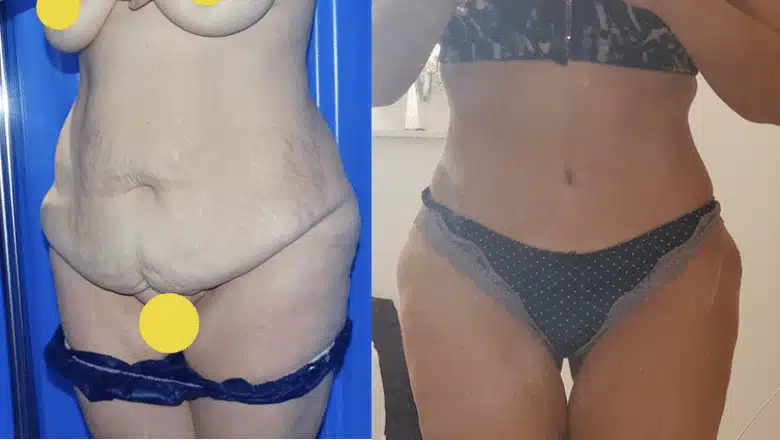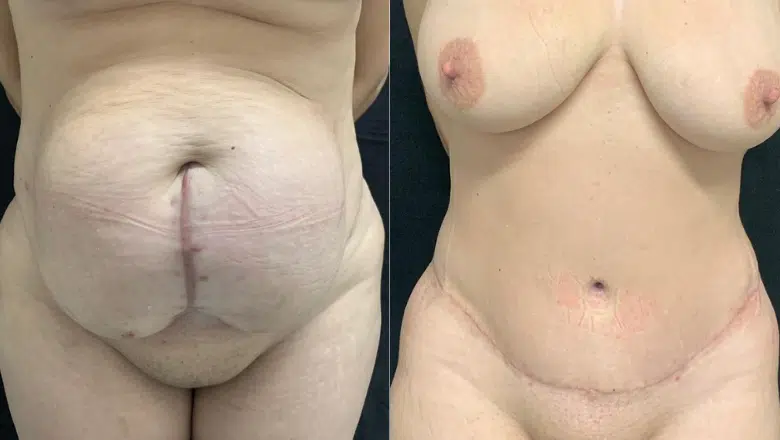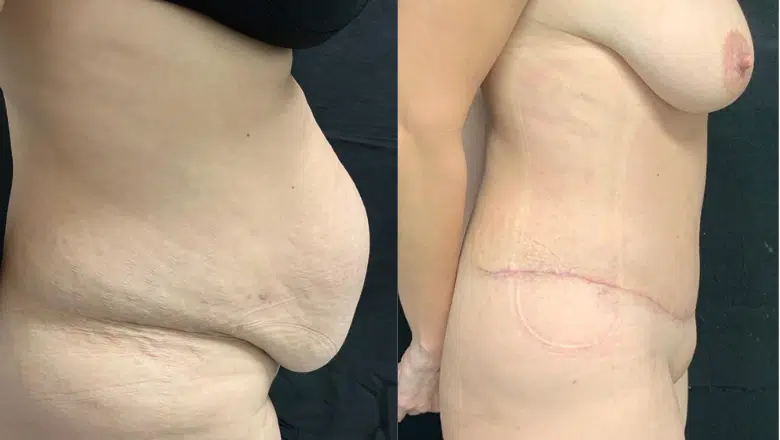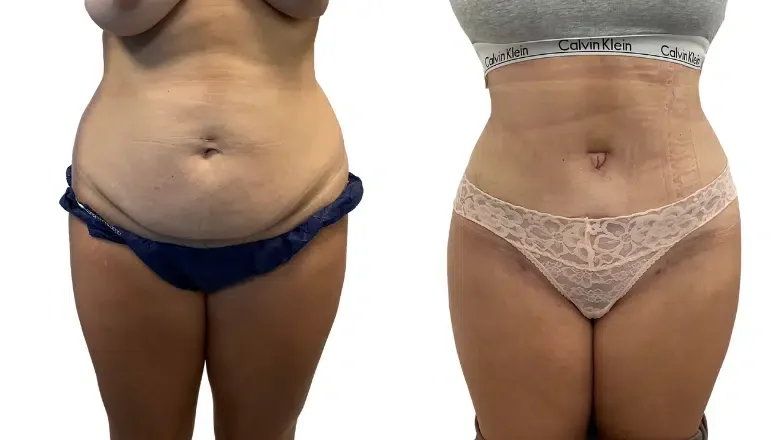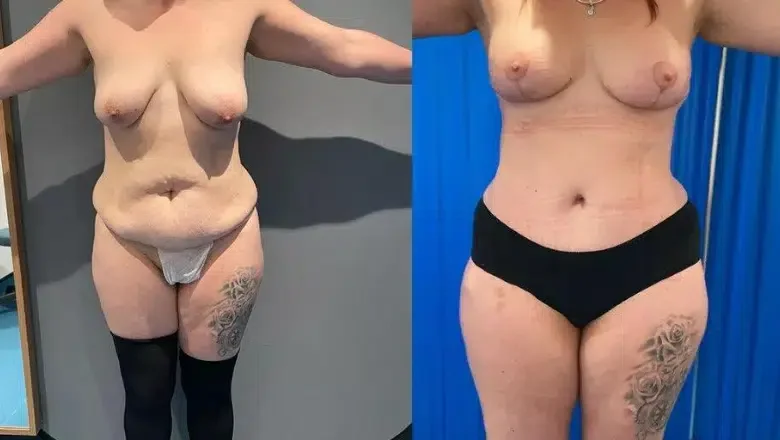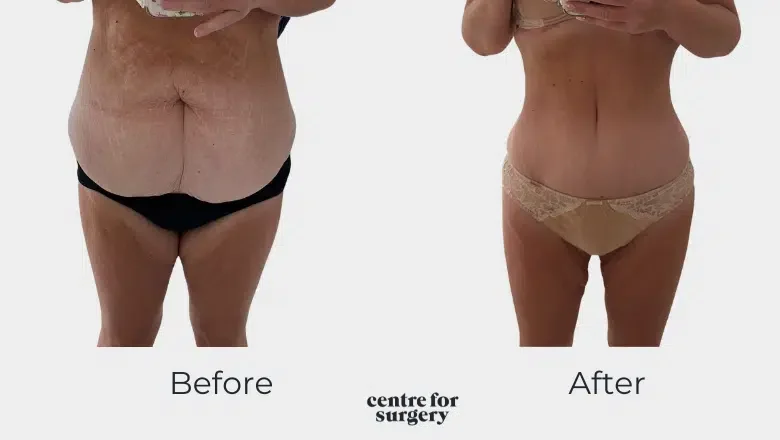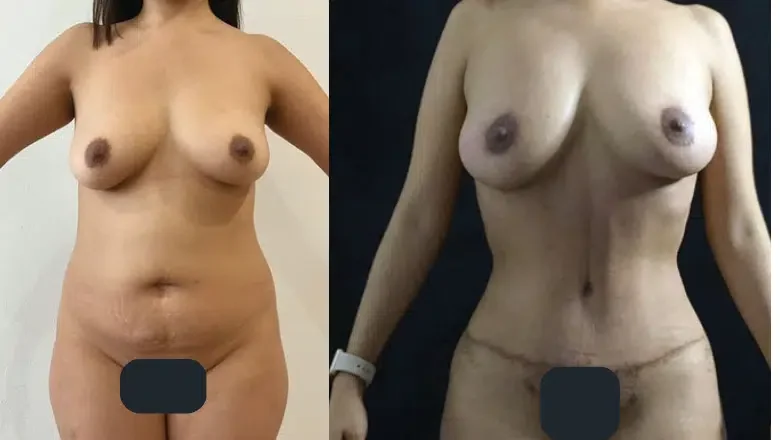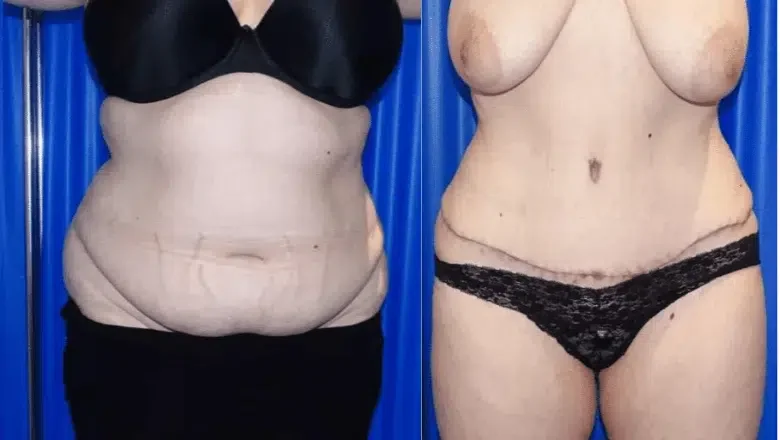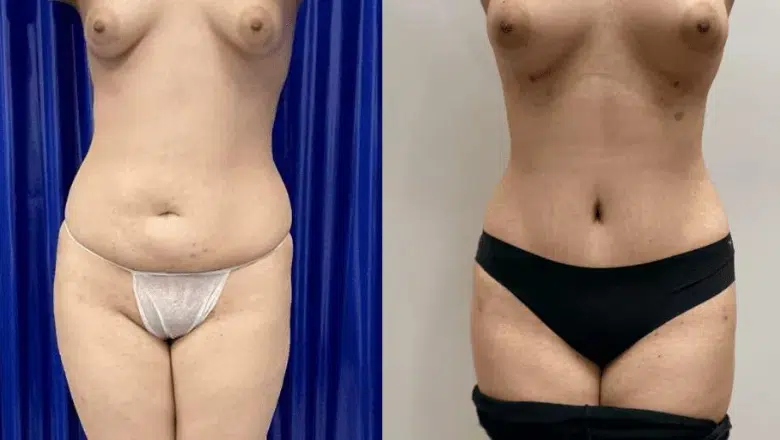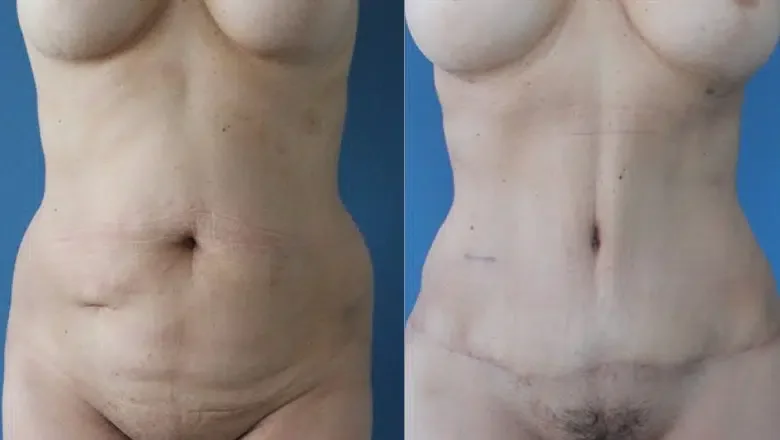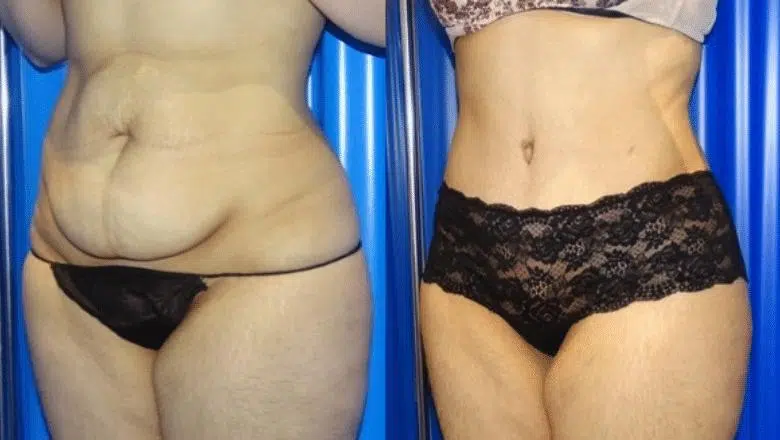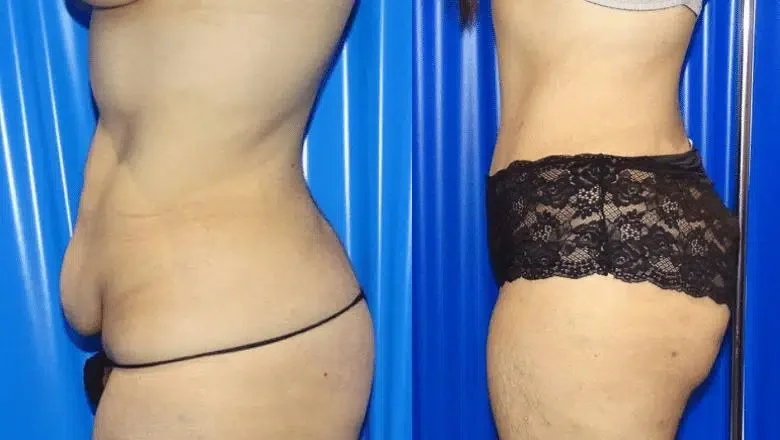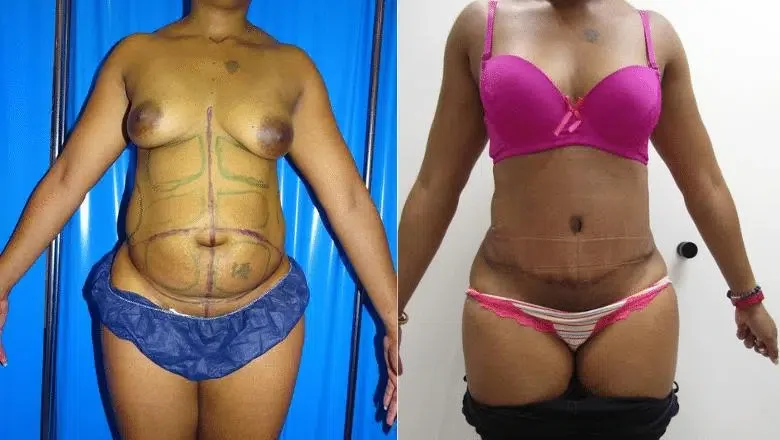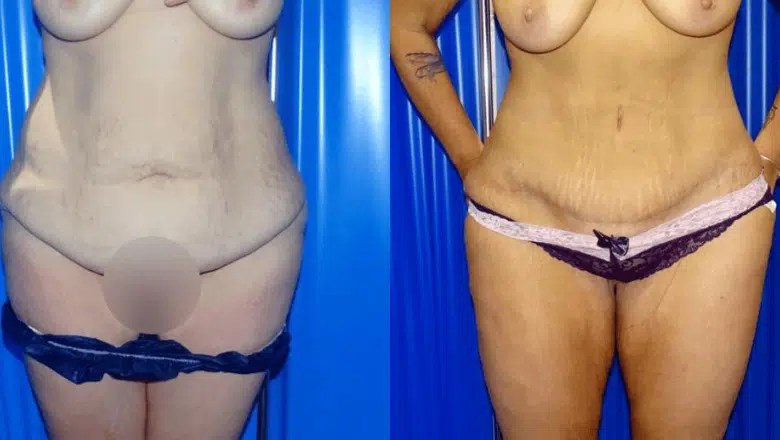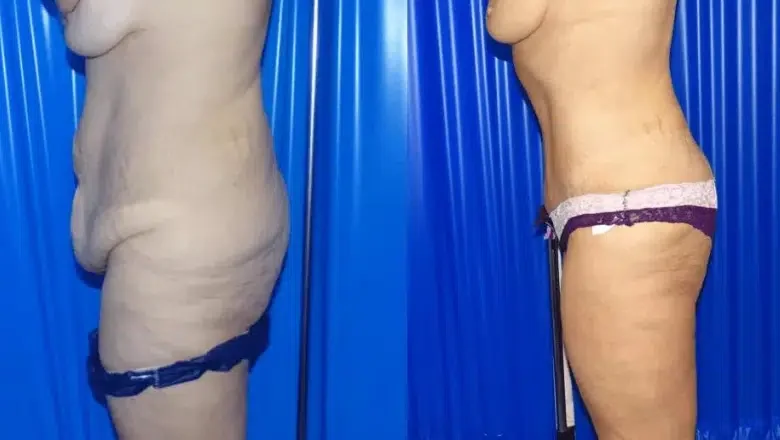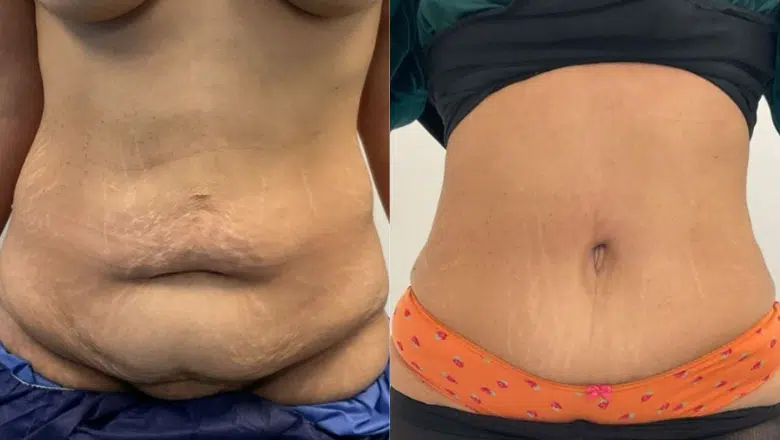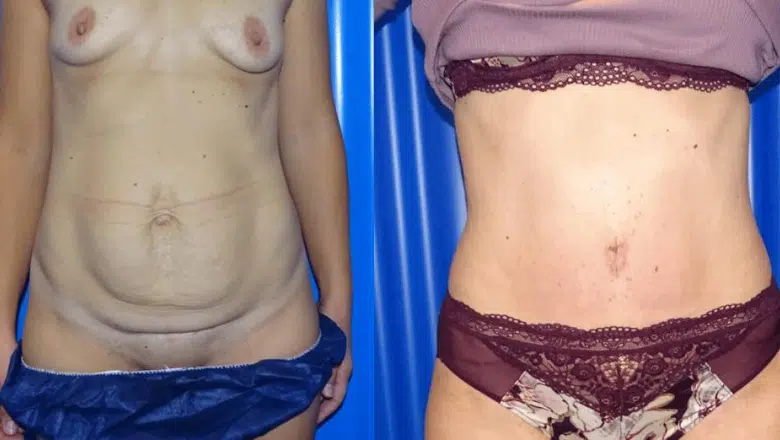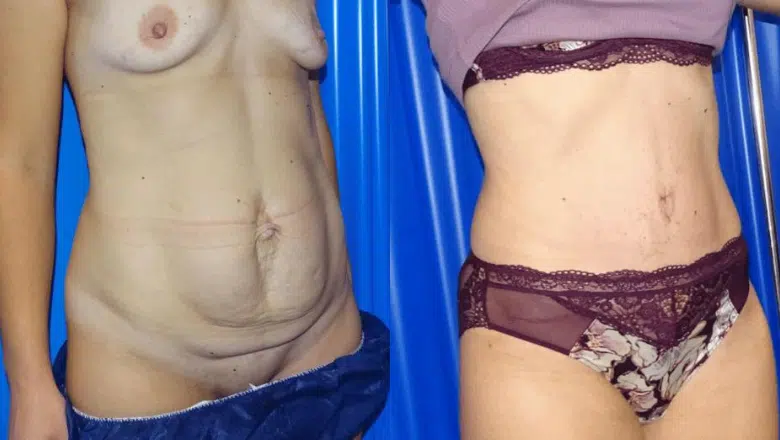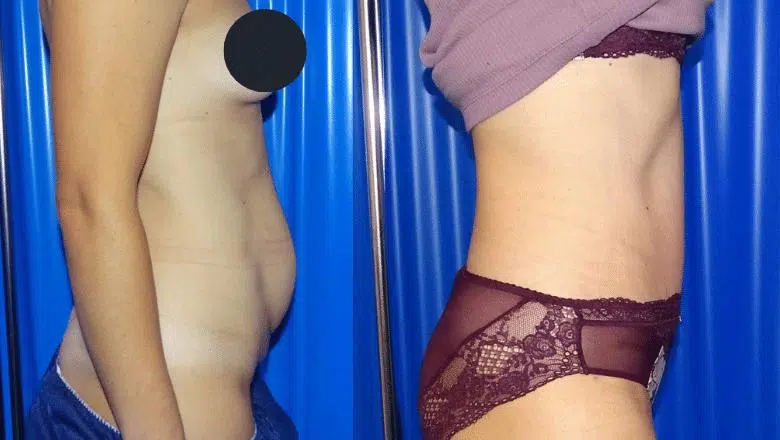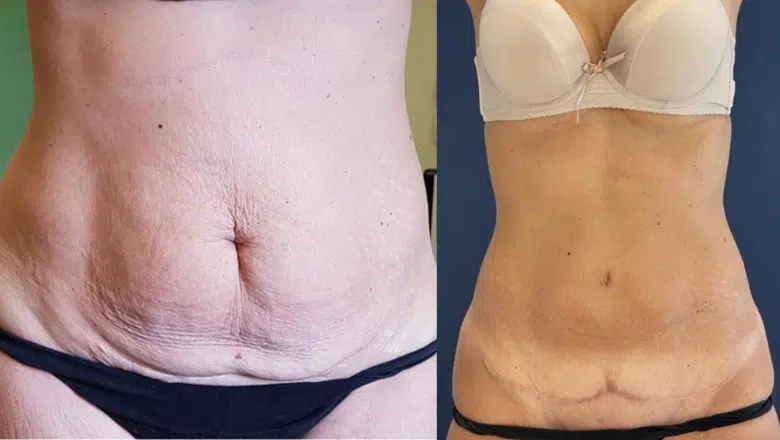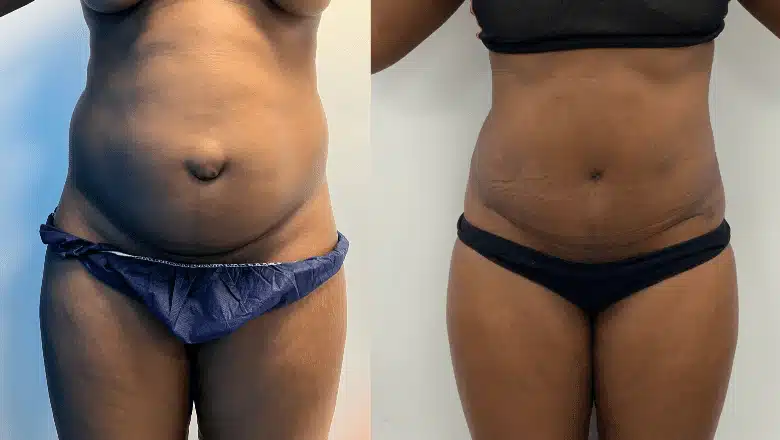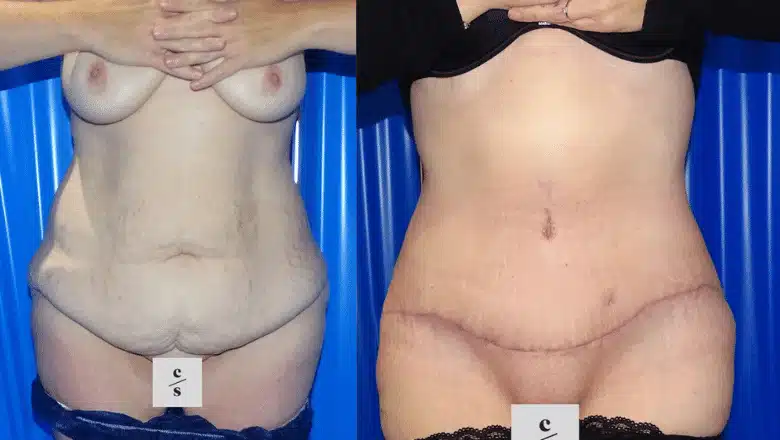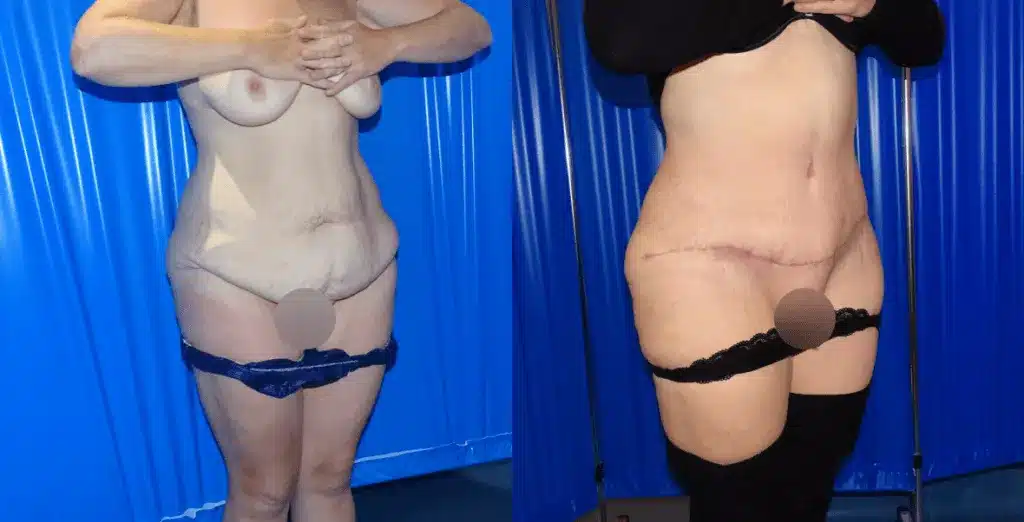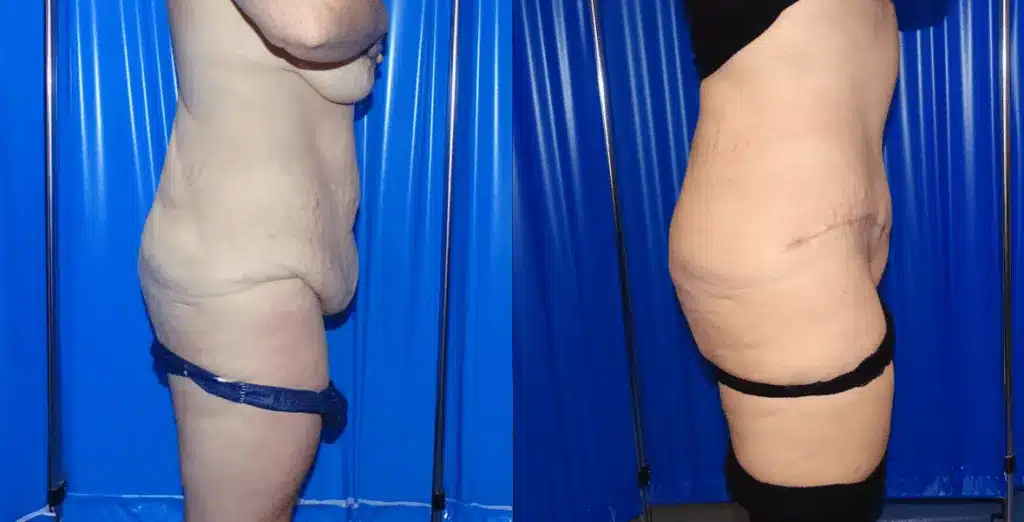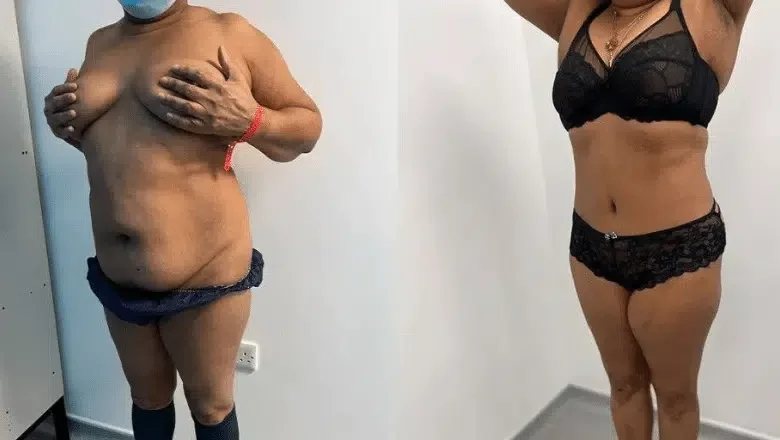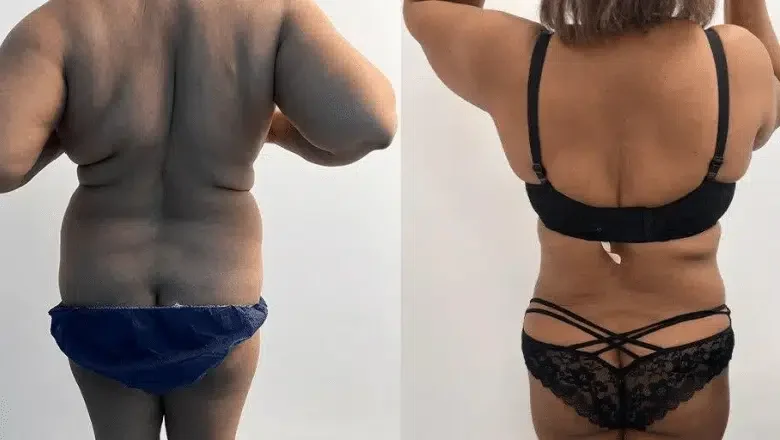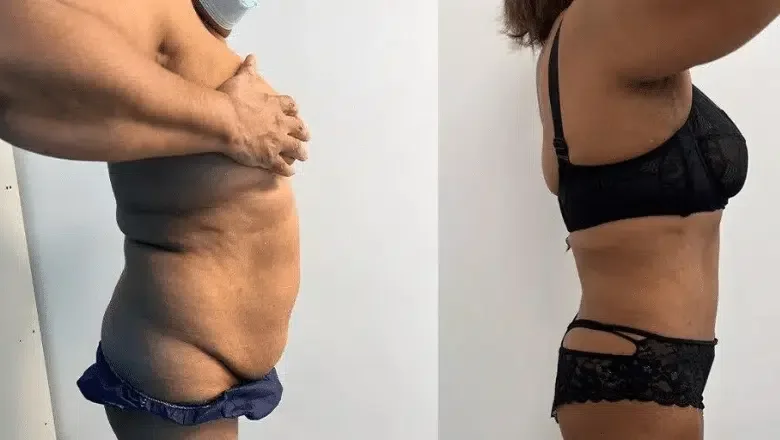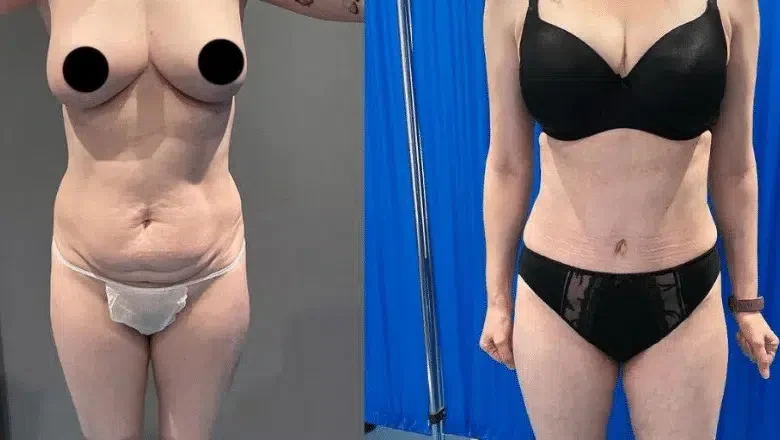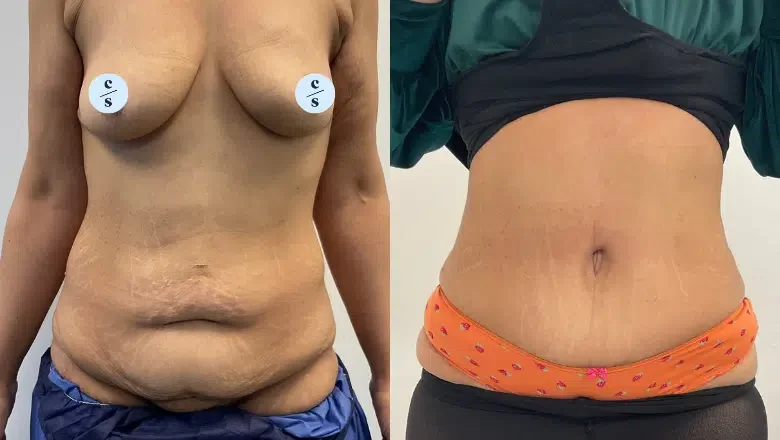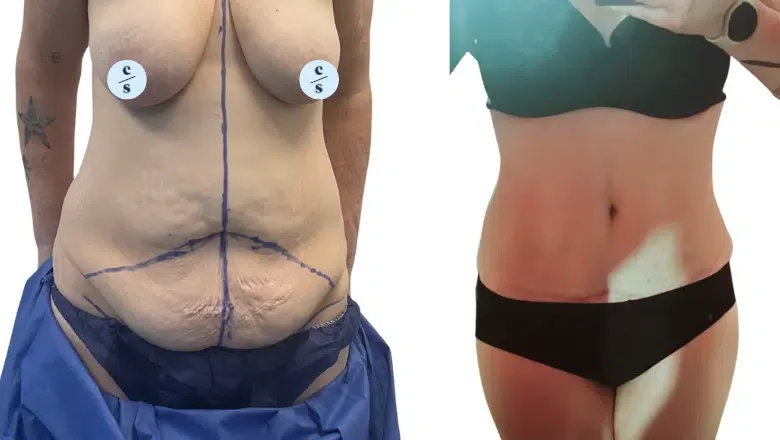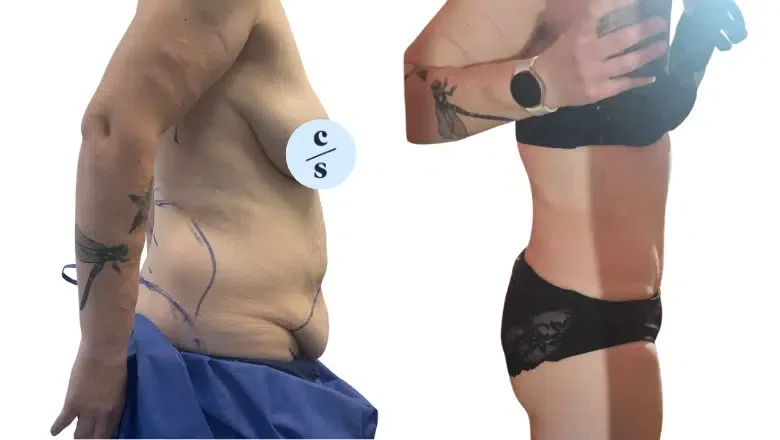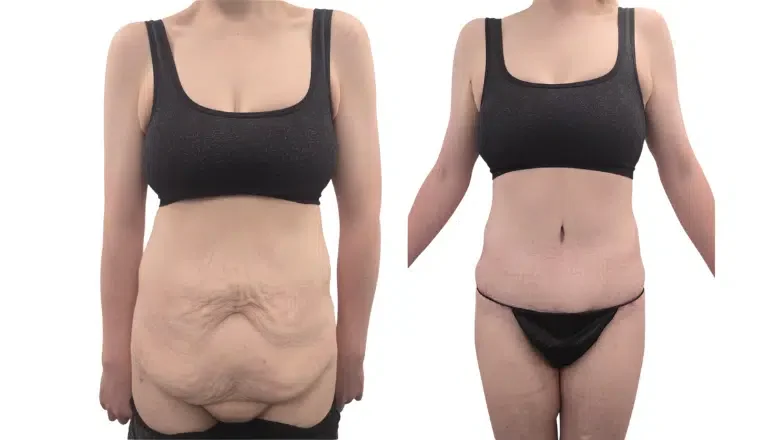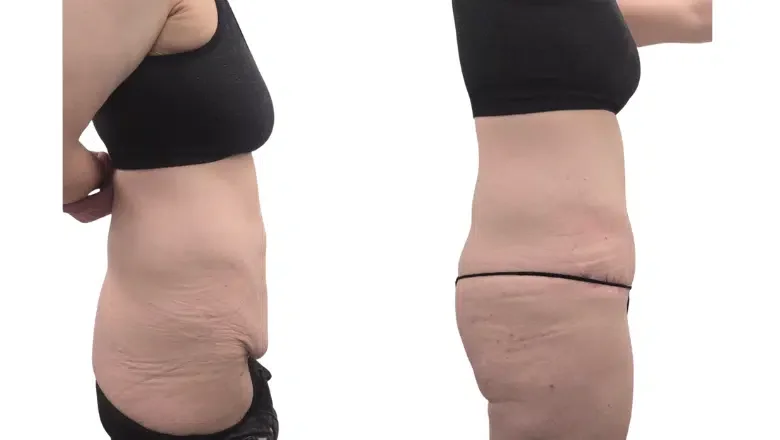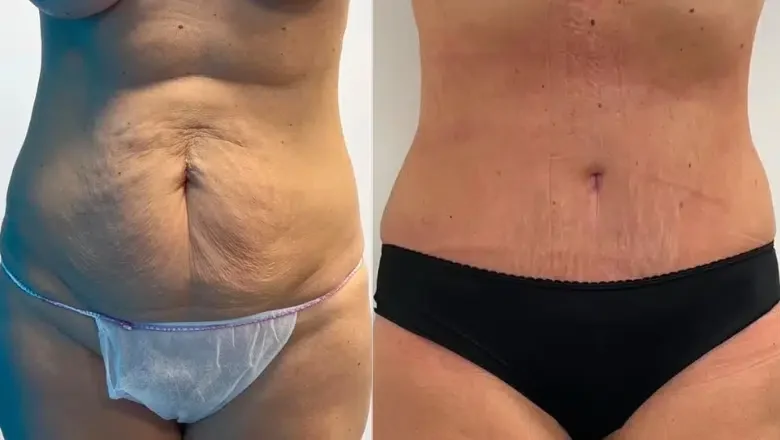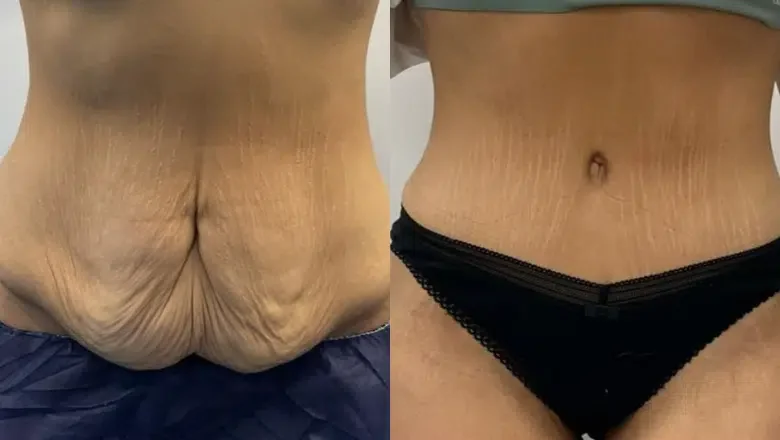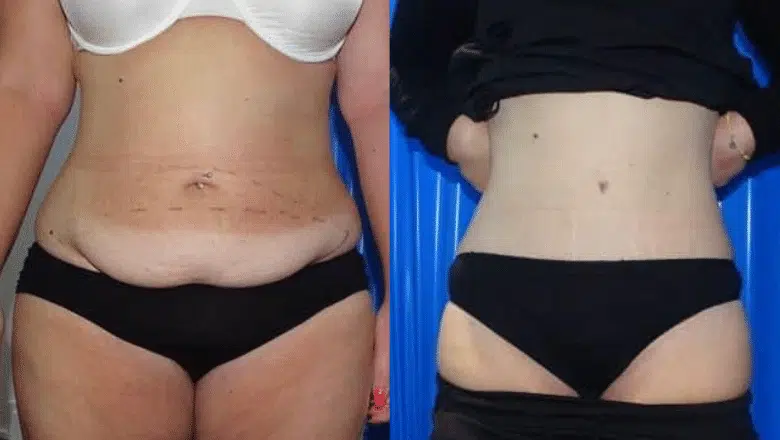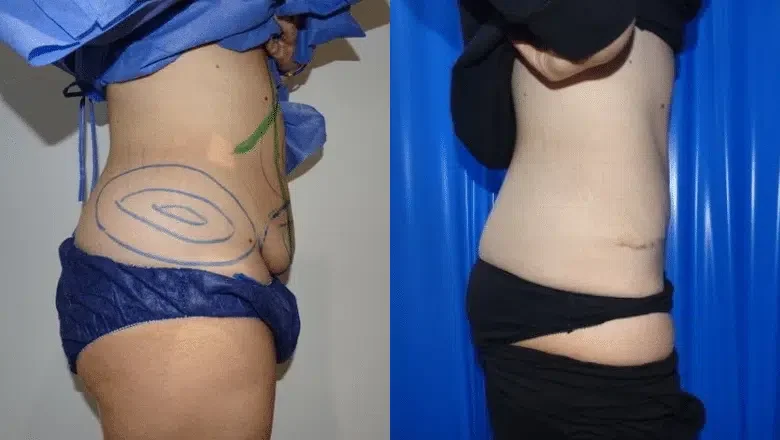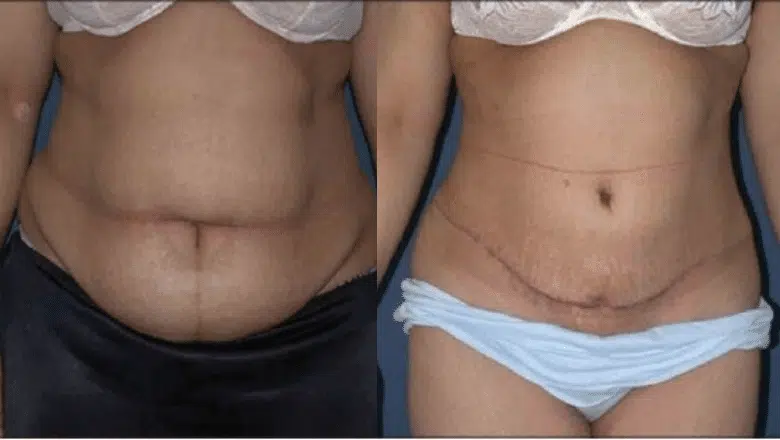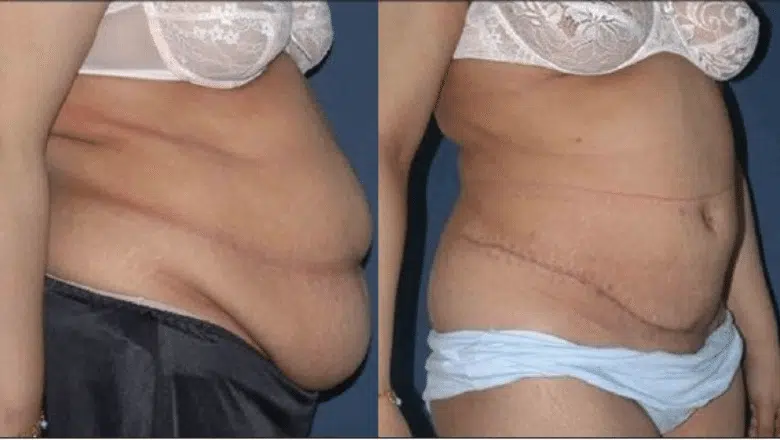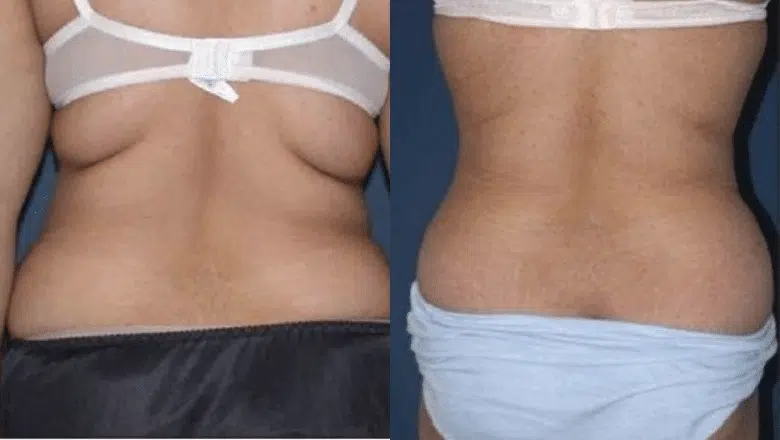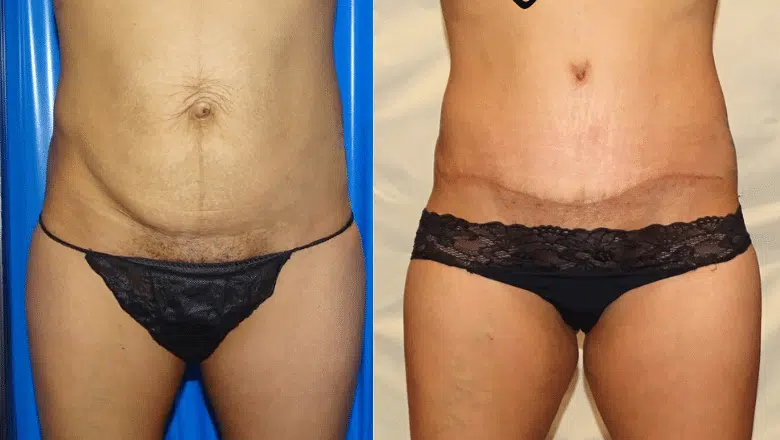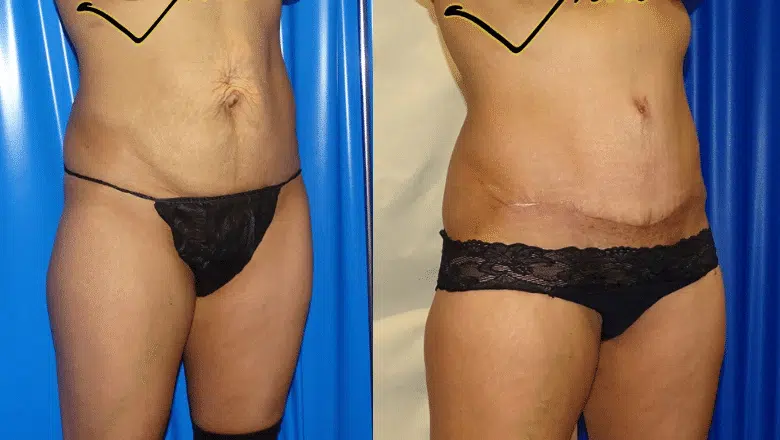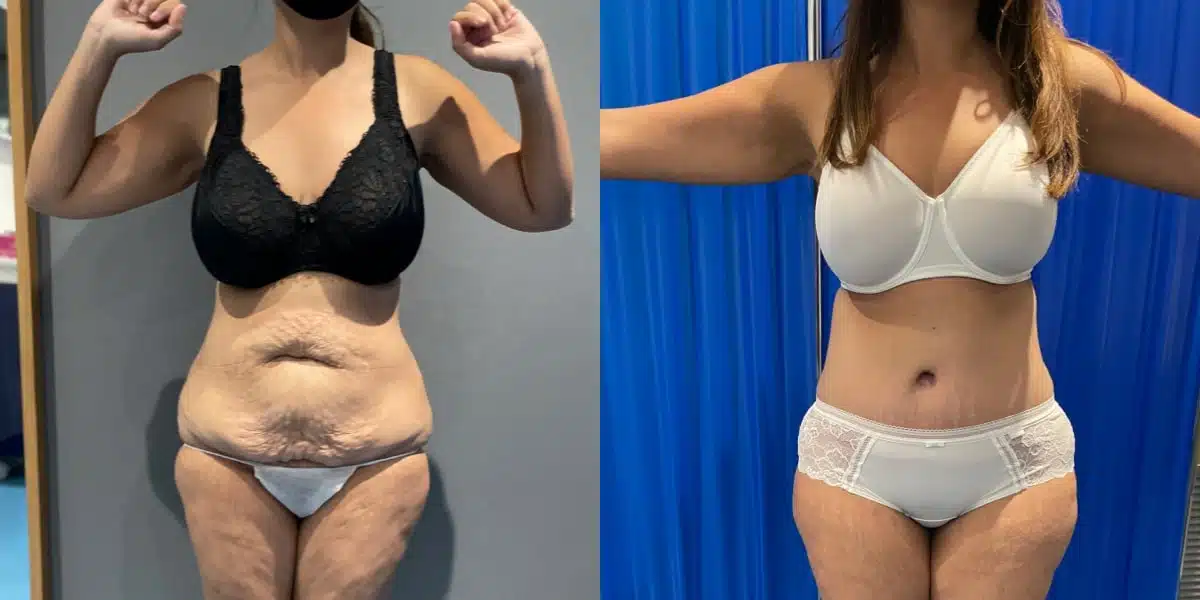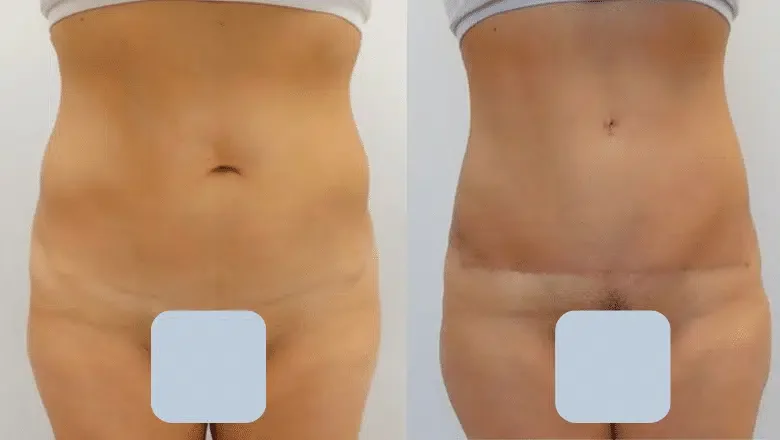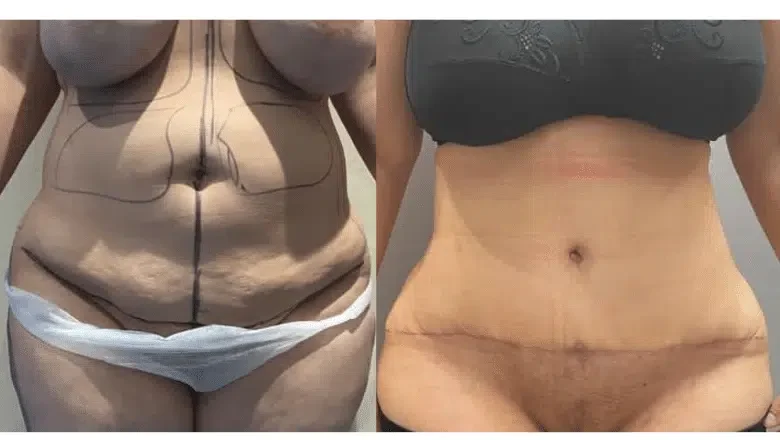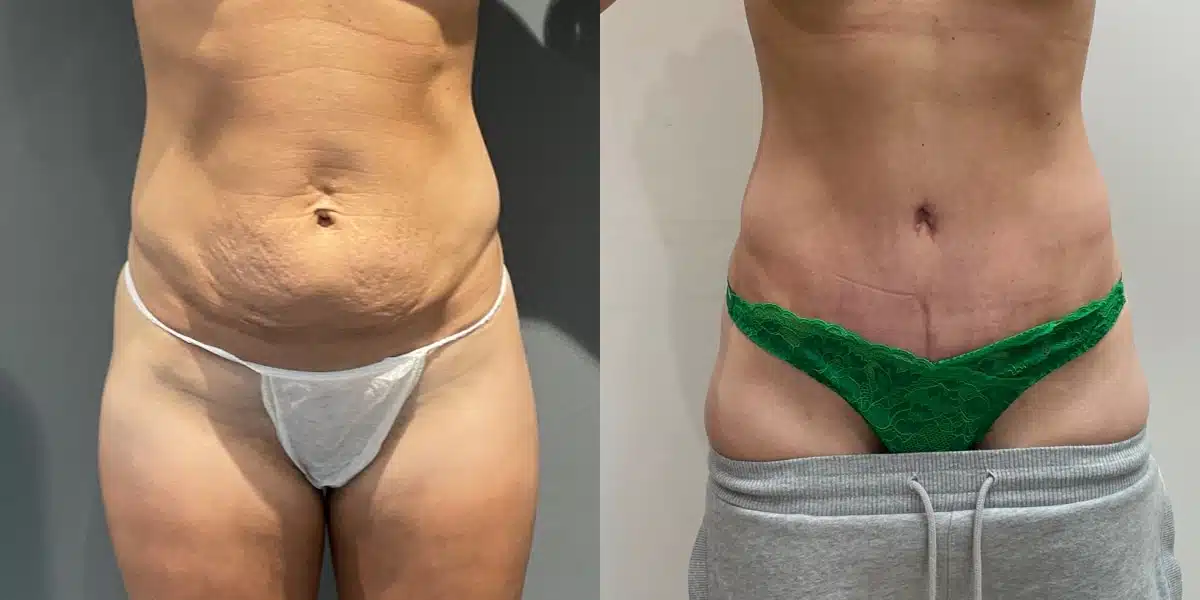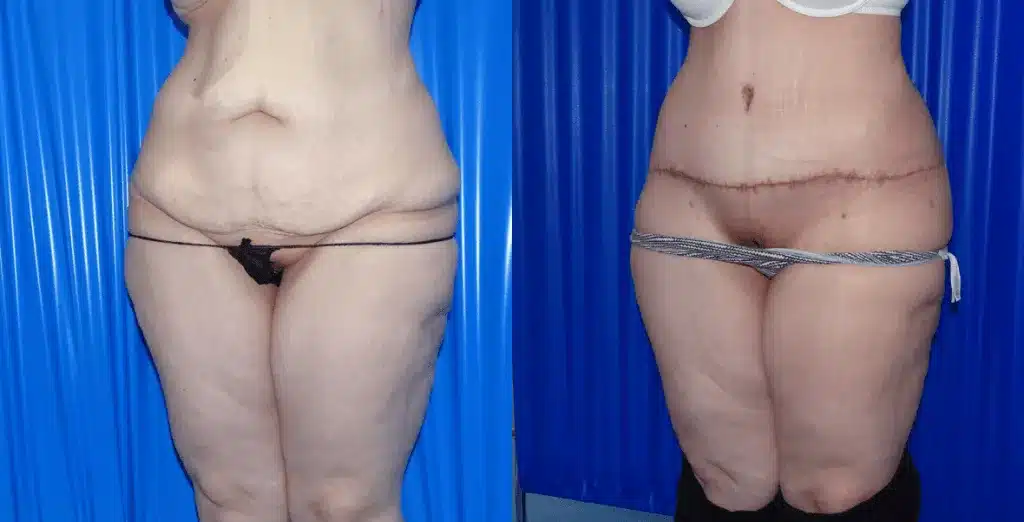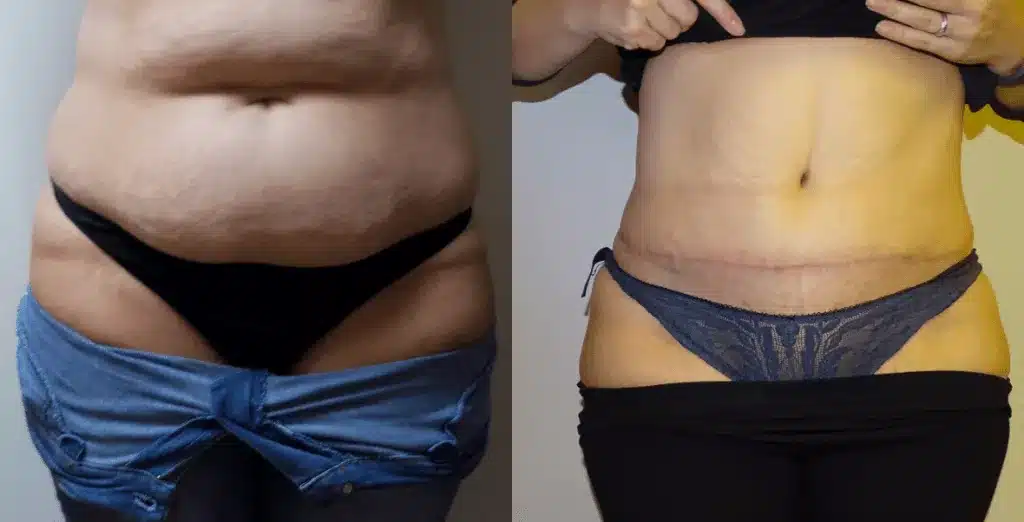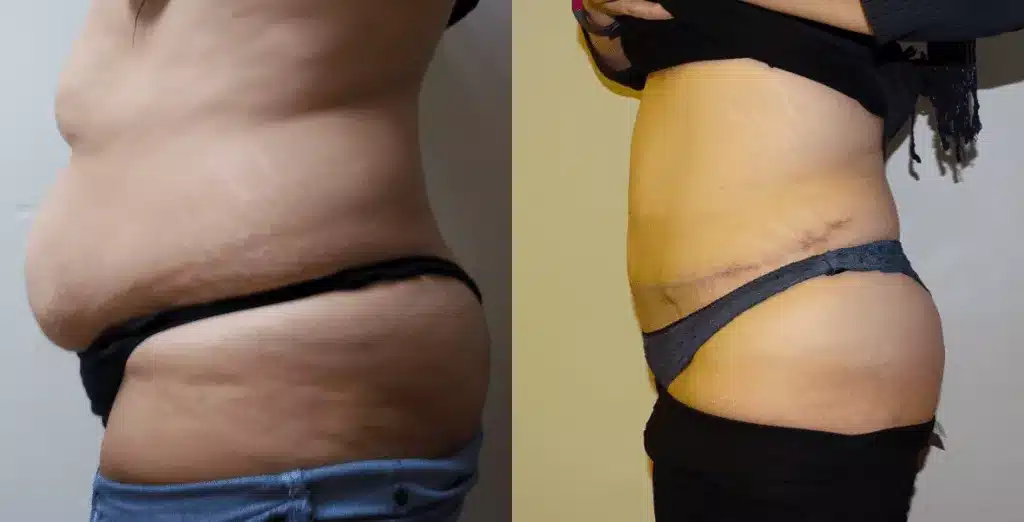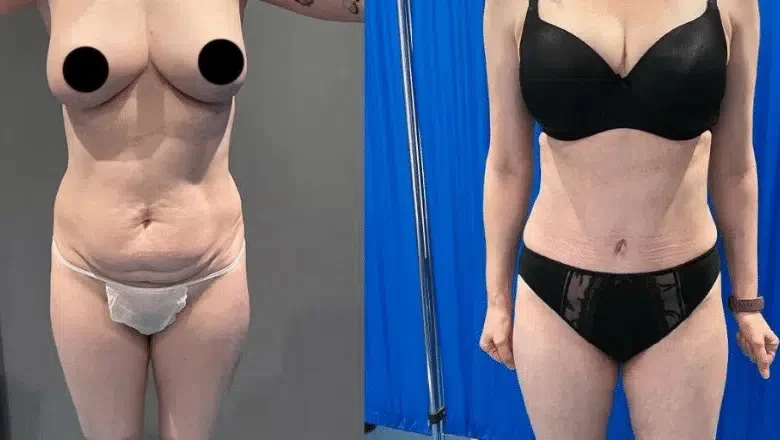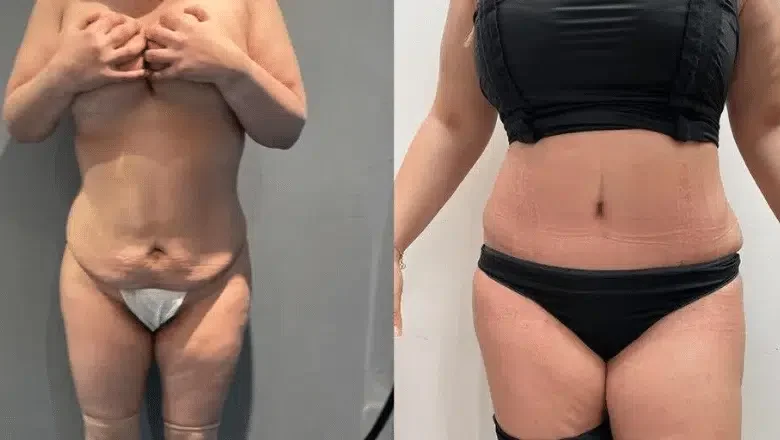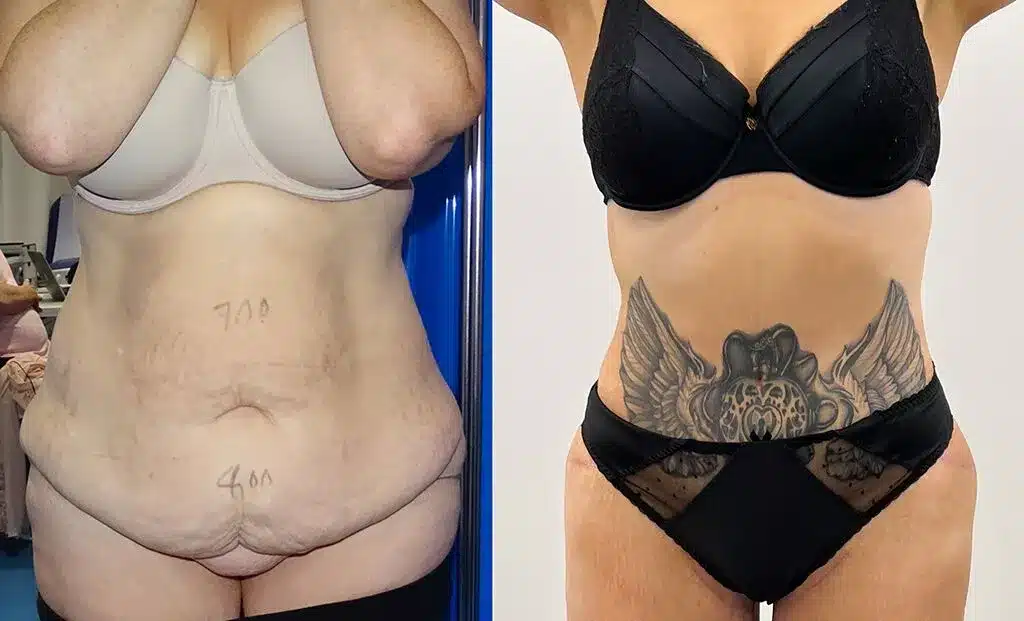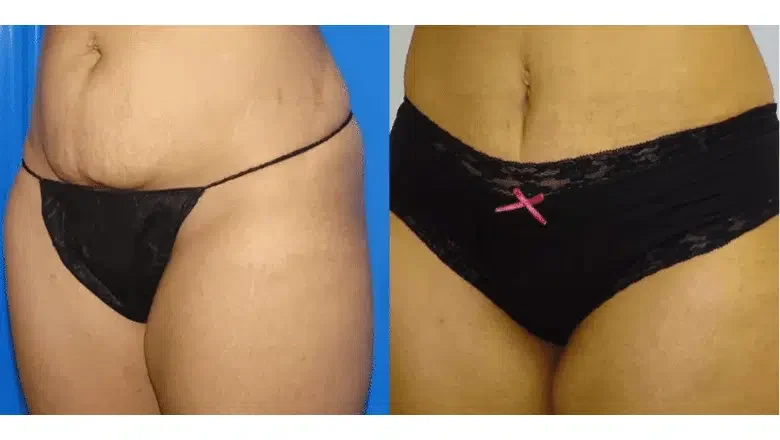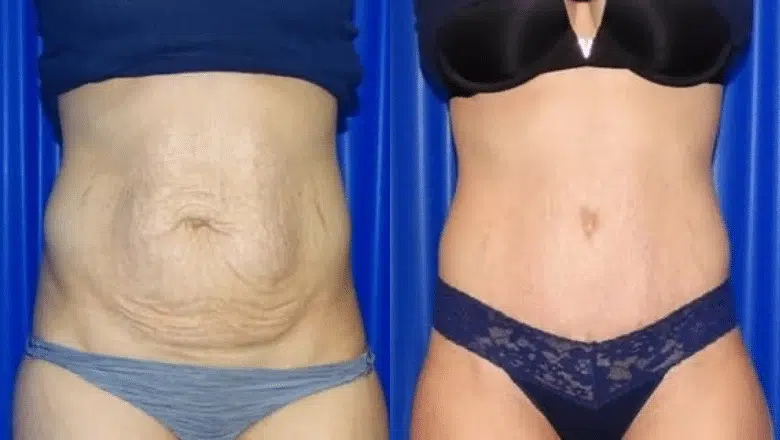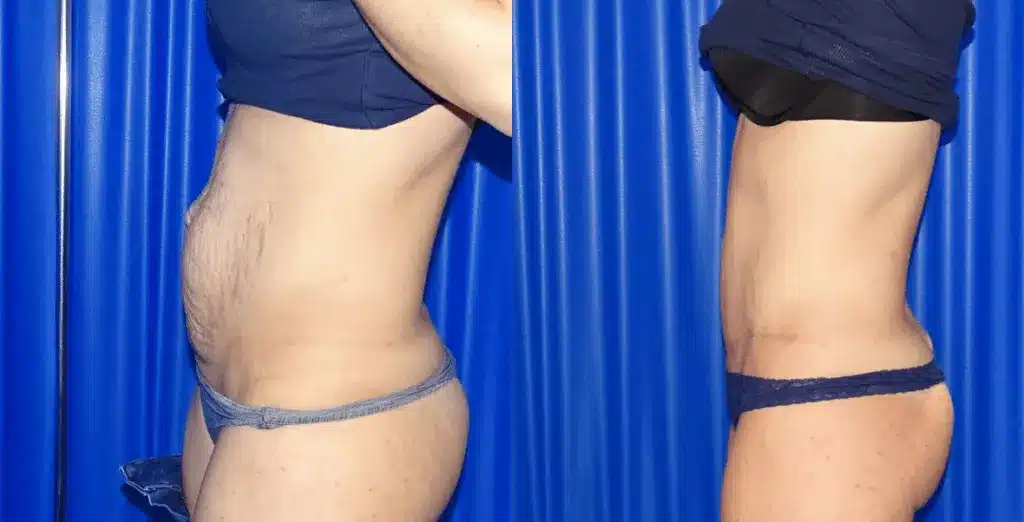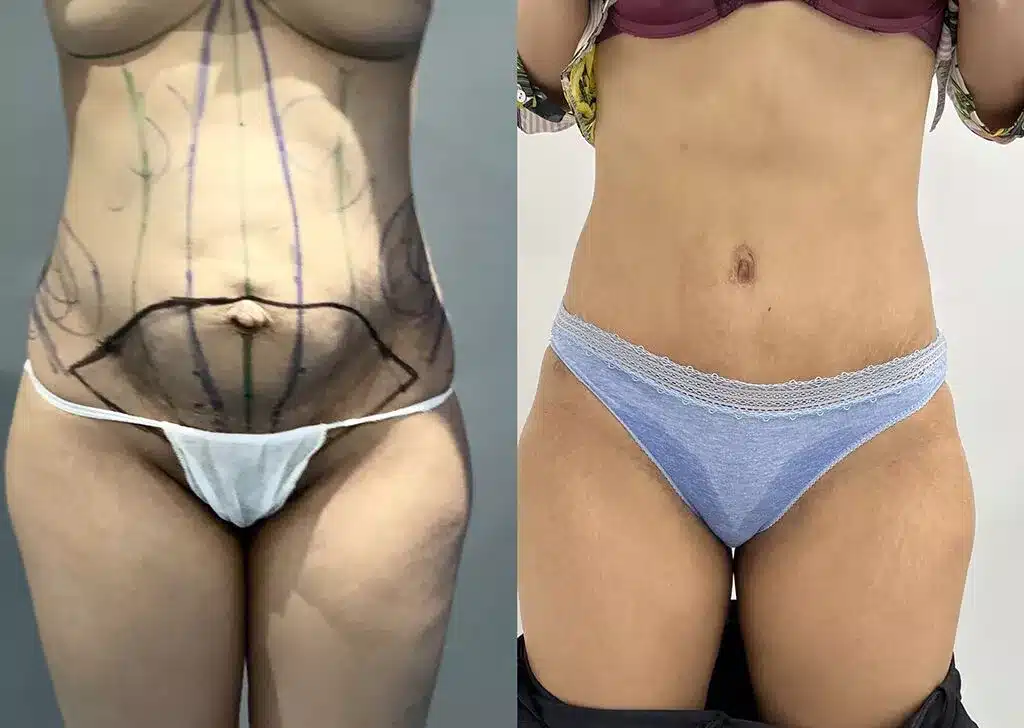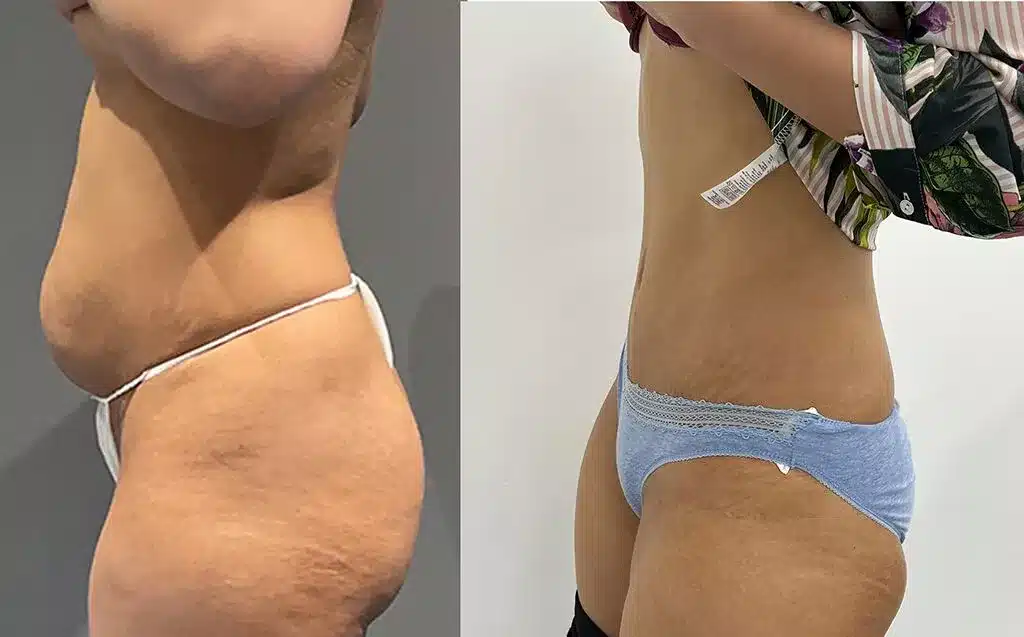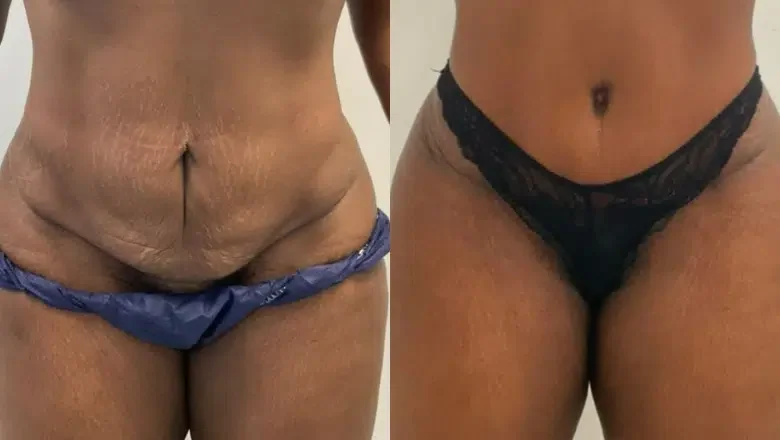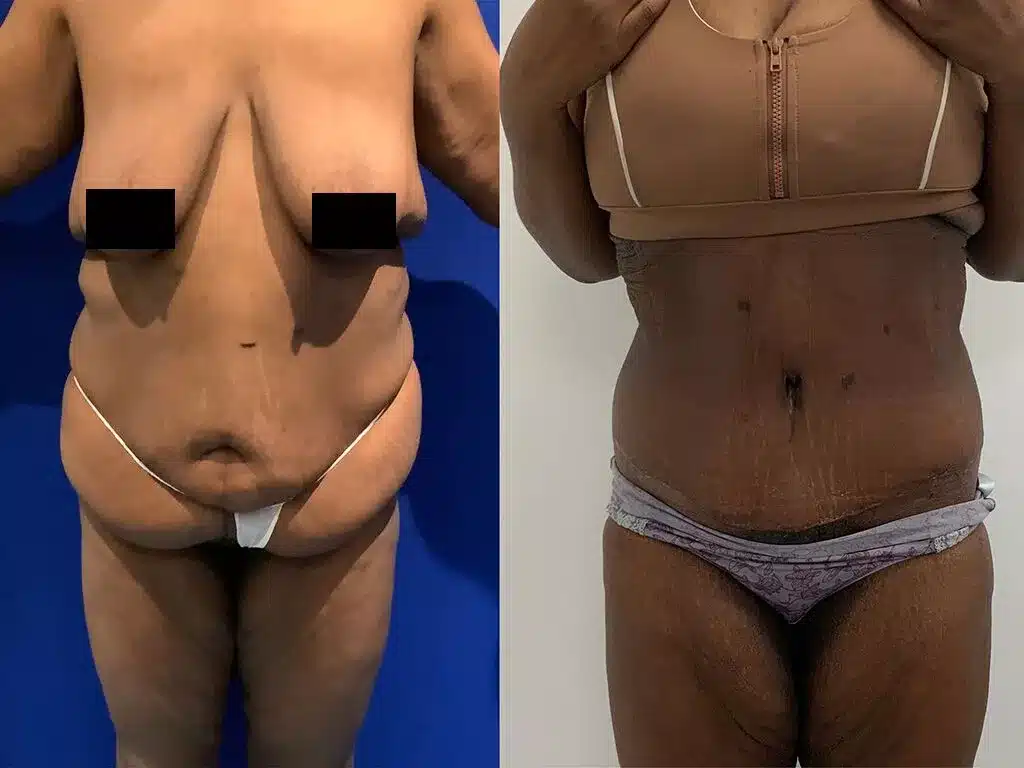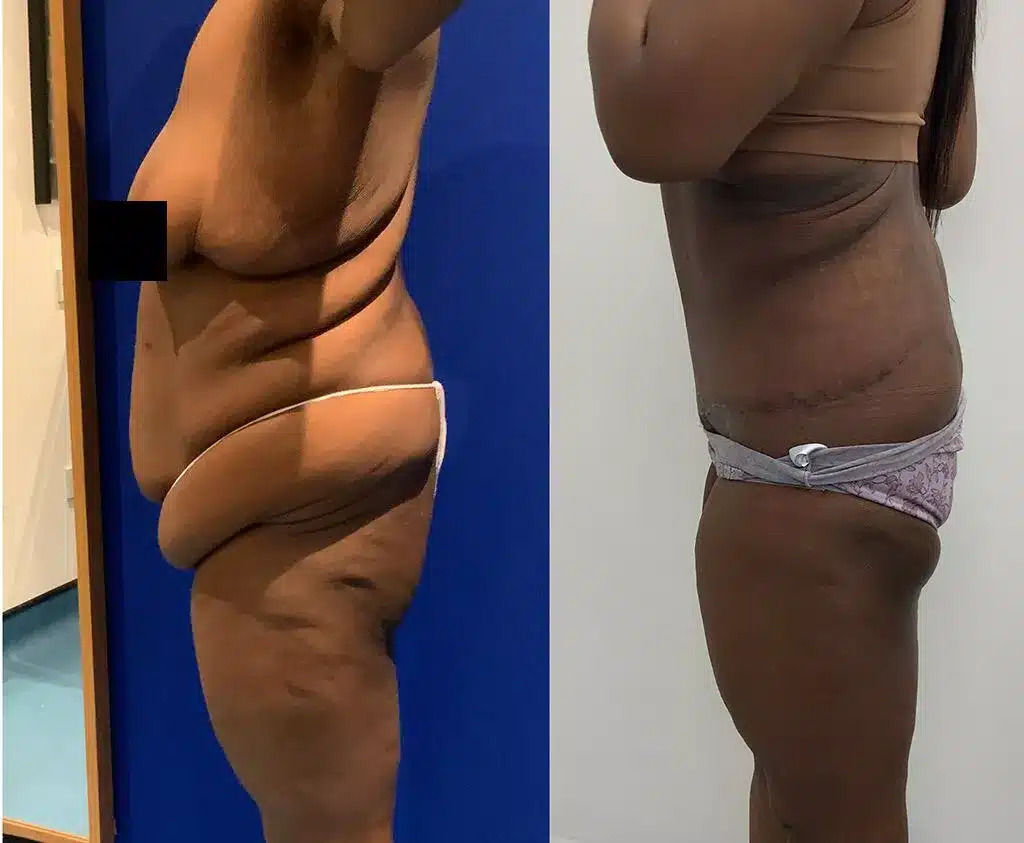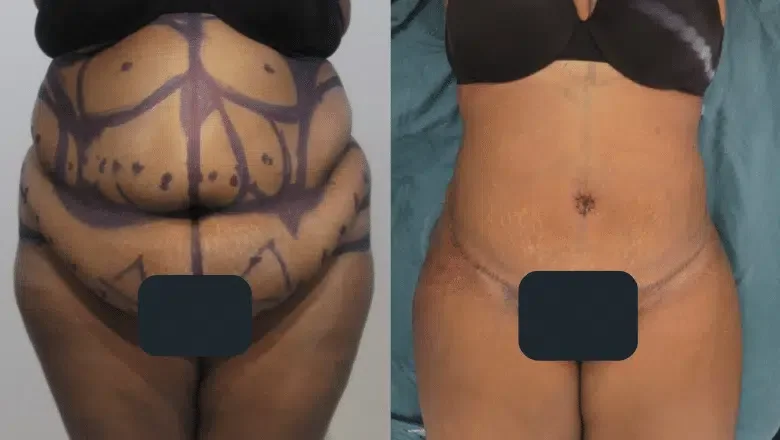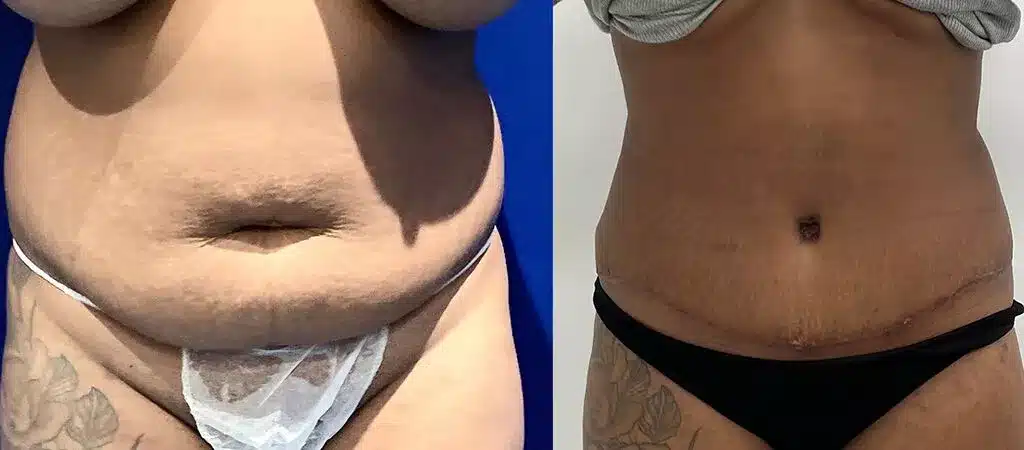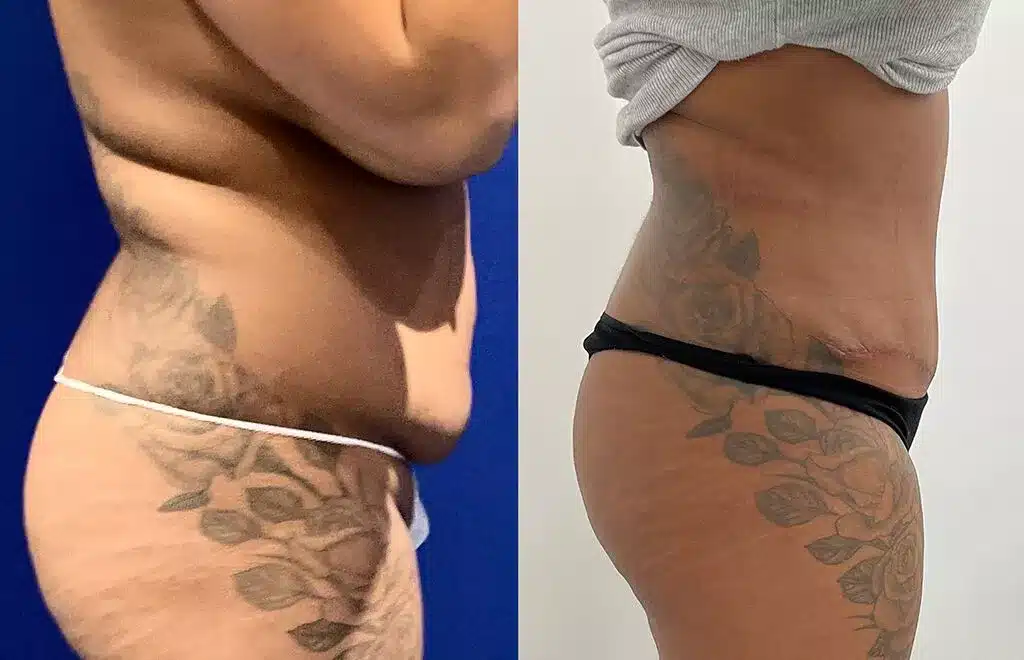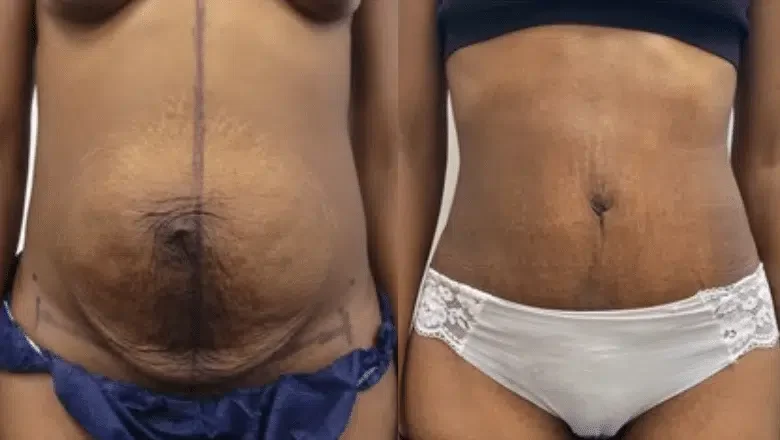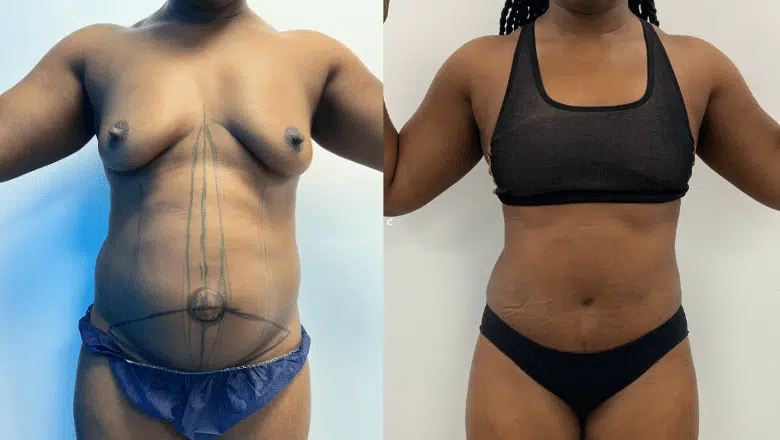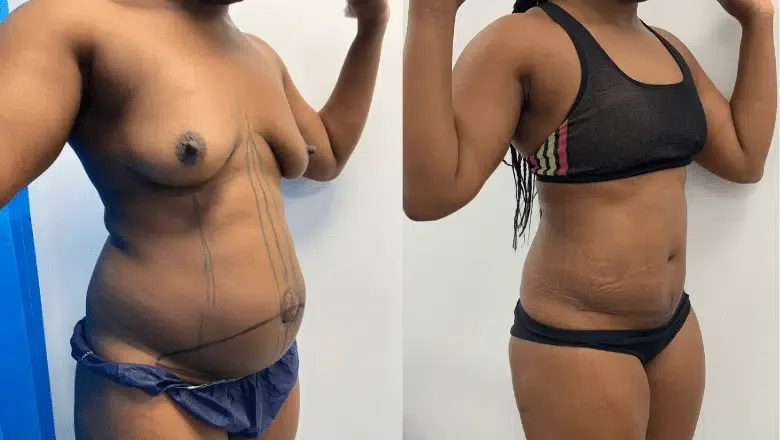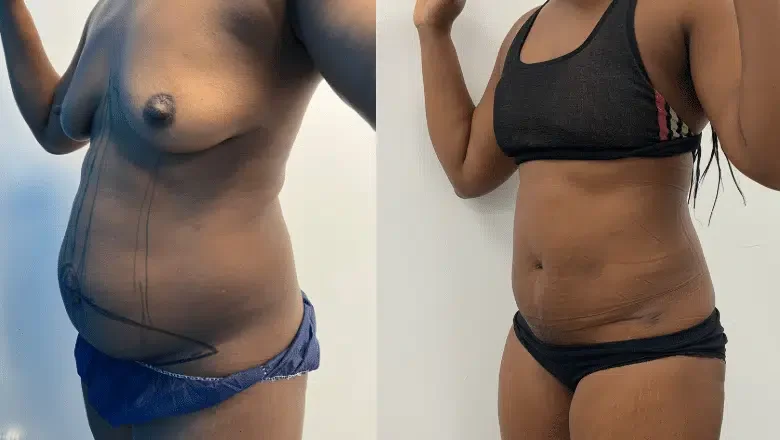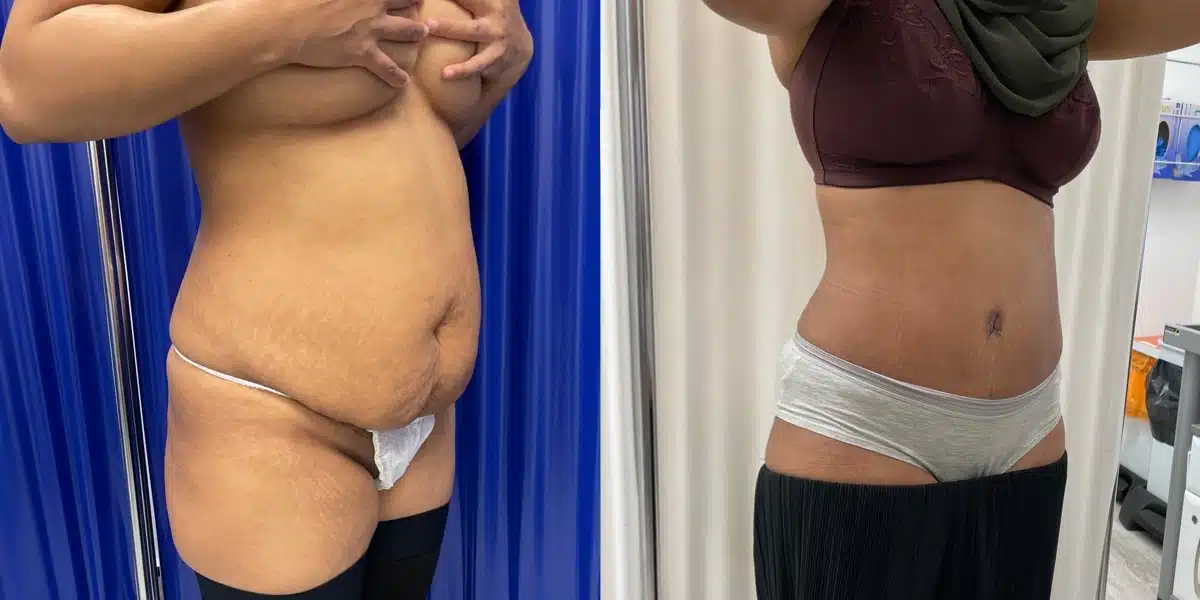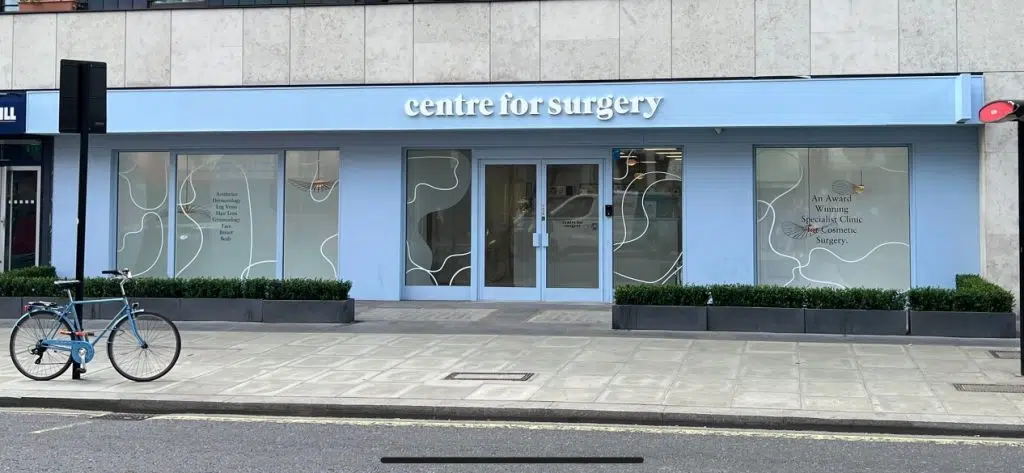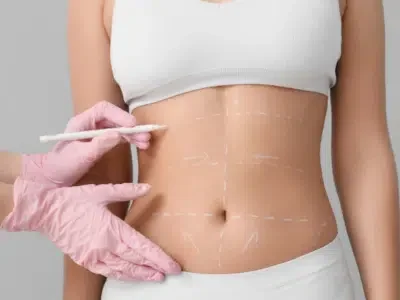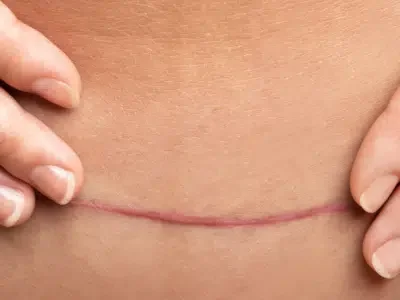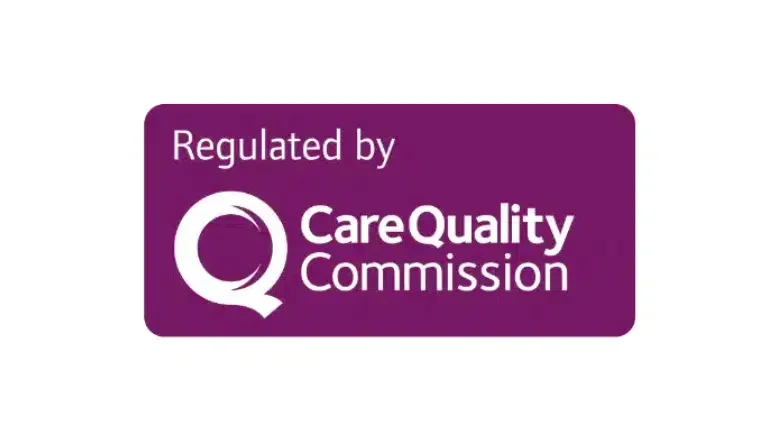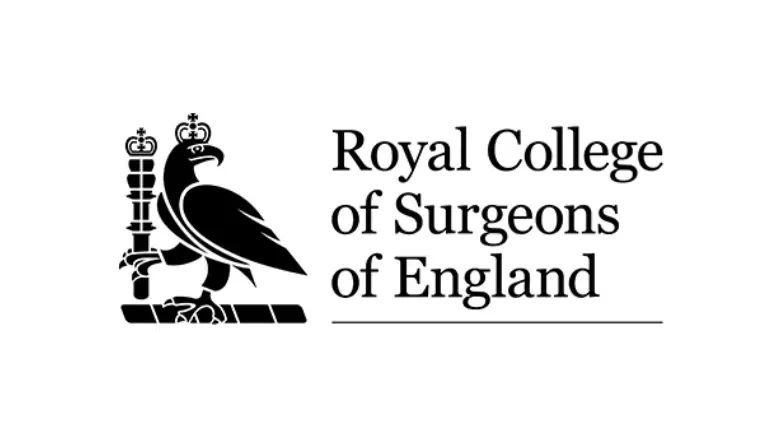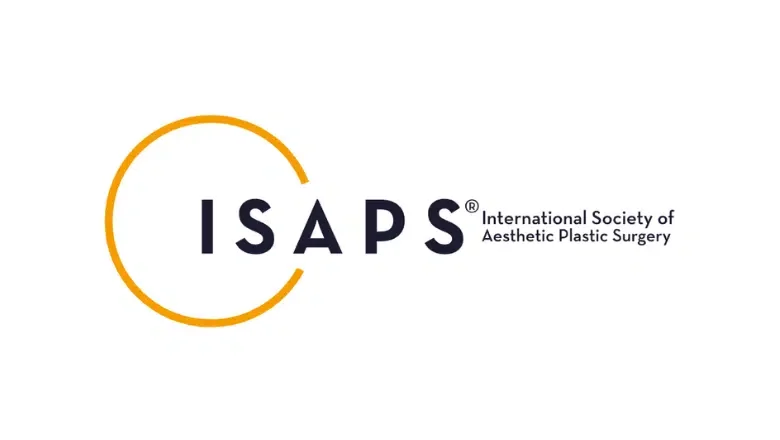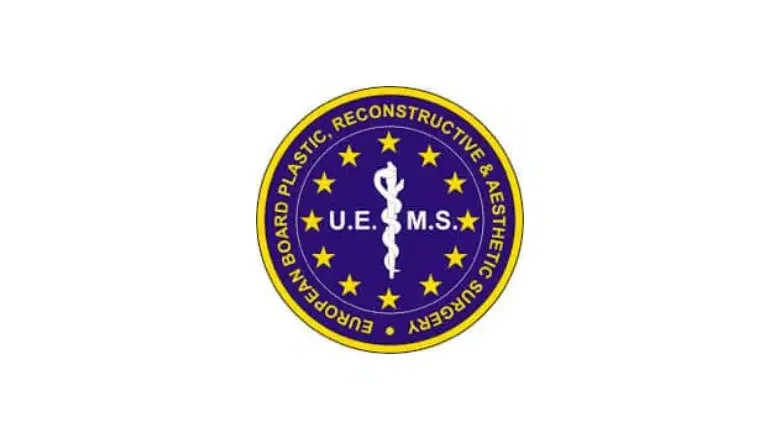Extended Tummy Tuck London UK
An extended tummy tuck, also known as an extended abdominoplasty or plus-size tummy tuck, is designed to remove excess skin and tissue from both the front and sides of the abdomen to achieve a more contoured and sculpted appearance. An extended tummy tuck is considered more surgically invasive than a traditional tummy tuck. It is most commonly performed in people who have lost significant weight either due to bariatric surgery or through natural means such as diet and exercise. Successful weight loss may result in the development of sagging skin and stretchmarks and can result in a significant loss of self-confidence, leading people to wear baggy clothing to hide their hanging folds of skin.
RELATED: Fleur de Lis Tummy Tuck
When people gain weight, fat most commonly accumulates in the abdominal region. When this excess fat is lost through diet and exercise or weight loss surgery, the stretched-out skin does not return to its original level of tightness. Saggy and drooping skin may result in the development of love handles. The stretched-out skin may also have extensive stretchmarks due to significant weight gain followed by weight loss. An extended abdominoplasty involves a longer incision compared with a standard tummy tuck to treat the areas of loose skin, which often extend outward to the sides (flanks) in people who have lost a significant amount of weight. An extended tummy tuck can achieve a more sculpted waistline and is commonly combined with other body contouring procedures, including liposuction or a breast lift.
RELATED: Benefits of Excess Skin Removal After Massive Weight Loss
What is an Extended Tummy Tuck Procedure?
The extended abdominoplasty procedure, also known as the extended tummy tuck, is an advanced cosmetic surgery technique aimed at enhancing the appearance and contour of the abdominal region. This procedure is designed to address not only the excess skin and fat in the midsection but also to tackle the unwanted tissue that extends around the flanks and lower back, providing a more comprehensive and aesthetically pleasing outcome.
RELATED: Extended Tummy Tuck FAQs – Q&A about Extended Abdominoplasty
The primary goal of the extended tummy tuck is to create a smoother, flatter, and more toned abdomen by eliminating excess skin and fat, as well as tightening the underlying muscles. This surgical intervention is particularly beneficial for individuals who have undergone significant weight loss or have experienced changes in their body shape due to pregnancy or ageing.
An extended abdominoplasty procedure differs from the traditional tummy tuck in the extent of the surgical intervention and the area it covers. While the conventional tummy tuck focuses on the abdominal region alone, the extended variation extends the incisions and treatment area to encompass the flanks and lower back. This results in a more comprehensive improvement in the patient’s overall body contour.
The extended tummy tuck procedure typically begins with the administration of general anaesthesia to ensure the patient’s comfort during the surgery. Following this, the surgeon makes a horizontal incision across the lower abdomen, just above the pubic hairline. This incision is typically longer than that used in a standard tummy tuck, as it needs to extend around the hips to address the excess tissue in the flanks and lower back.
Once the incision has been made, the surgeon lifts the skin and fat layer away from the underlying abdominal muscles. These muscles are then tightened and stitched together, creating a firmer and more toned abdominal wall. Next, the surgeon removes the excess skin and fat, carefully pulling the remaining skin downward and trimming away any surplus tissue before suturing it.
Sometimes, the surgeon may also perform liposuction to remove additional fat deposits and further enhance the patient’s body contour. This combination of procedures helps to create a smoother and more aesthetically pleasing result, with an overall improvement in the appearance of the abdominal region, flanks, and lower back.
Extended Tummy Tuck Before and After Photos
At your consultation, your surgeon will be able to show you a wide range of before and after extended tummy tuck photos to give you an idea of the results that can be achieved with surgery. Every patient is different, and an extended tummy tuck is always customised to fit the needs and preferences of the individual patient to get the best possible results.
Gallery 1
Gallery 2
African-Caribbean Tummy Tuck
Benefits of the Extended Tummy Tuck Procedure
When you’re pregnant, your body changes a lot. Many women put on at least 10 kg during their nine months of pregnancy. Most of that weight goes away after the baby is born, but sometimes, your skin doesn’t return to how it used to be. It’s not just pregnancy that does this; if you lose a lot of weight quickly, you might find that your skin starts to sag. Unfortunately, even the best diet and most rigorous exercise routine can’t always help sagging skin bounce back.
RELATED: Benefits of Excess Skin Removal After Massive Weight Loss
This can really knock your confidence and make you feel self-conscious. You might start avoiding social events, or even everyday activities like walking can become uncomfortable. The sagging skin can sometimes lead to problems like skin irritation, rashes, or even infections. When skin rubs against skin, it can cause discomfort that makes it difficult to walk or move about as you normally would.
Everyone’s skin is different, and for some people, the skin does recover quite well after weight loss or childbirth. But for many, sagging skin is a permanent change they’re not happy with. Several things play a part in how elastic your skin is, including natural ageing and how much time you’ve spent in the sun. Too much sun exposure can also make the problem worse.
RELATED: Medical Benefits of a Tummy Tuck
An extended tummy tuck surgery could be a solution for you. This procedure can give you a flatter stomach and a slimmer waistline, with results that last as long as you manage to maintain your weight. The surgery removes the saggy skin so that your stomach looks tighter and younger. Diet and exercise alone can’t give you these results.
After getting an extended tummy tuck, your stomach area looks much more toned. The shape of your abdomen will be more defined and flatter. The procedure can often be combined with liposuction to get rid of ‘love handles‘ or other fatty areas. Each surgery is tailored to what you need and hope to achieve. The drastic change depends on how much loose skin you start with.
Apart from helping you look better, an extended tummy tuck can also improve your quality of life. For example, some people experience back pain because of the extra loose skin and weak stomach muscles. The surgery can help with this. If sagging skin has kept you from being active or going to the gym, this surgery can help you get back to doing what you love, whether playing tennis or hitting the gym with confidence.
Am I suitable for an extended tummy tuck?
Although a standard tummy tuck is a suitable treatment for loose skin affecting the front of the abdomen, an extended tummy tuck can better treat loose skin, extending outwards to the flanks. Patients who have achieved significant weight loss inevitably develop loose and saggy skin, which does not return to its original level of elasticity. As well as being a common source of cosmetic concern, many people may develop symptoms from excess skin, resulting in a loss of self-confidence. Loose skin may develop due to pregnancy or significant weight loss, and typical symptoms experienced include:
- Excess skin folds may cause irritation and pain
- Stretchmarks
- Skin rashes
- Hanging skin may cover the pubic area partially or completely
- Inability to wear certain types of clothing due to excess skin
An extended tummy tuck is a major surgery and a small surgically invasive compared with a traditional tummy tuck. The risk of complications is minimised by ensuring suitable patients are selected for the procedure.
Although there is no defined age limit for having an extended tummy tuck, patients should be at least 18 years of age. Most patients who are considering an extended tummy tuck have either experience childbirth or have lost a significant amount of weight. This can affect people from their 20s all the way to their 60s.
Good overall physical and mental health and no chronic medical conditions, such as uncontrolled high blood pressure or severe diabetes, are the main prerequisites for suitability for an extended abdominoplasty. Your doctor will also want to know if you are taking certain medications, as medicines containing aspirin may increase the risk of bleeding both during and after the procedure. It would be best if you informed your surgeon about all your medications at your consultation.
Patients should be at a stable weight below a body mass index of 30. Patients who are significantly overweight or obese are not considered ideal for the procedure due to the risk of complications occurring both during and after the procedure, including delayed wound healing and wound infection.
At the consultation, your surgeon will discuss extended tummy tuck surgery’s risks and potential complications. It is important for patients to be aware of the results that could be achieved after an extended tummy tuck and how long they last. All patients should take certain preoperative steps to ensure they are optimally prepared for surgery. Patients should have realistic expectations of what an extended abdominoplasty can achieve. You should follow all of your surgeon’s preoperative and post-operative instructions to get the best possible results. People who smoke will need to stop smoking at least four weeks before surgery. This is because smoking has a detrimental effect on healing and recovery, with an increased risk of wound complications.
What does an extended tummy tuck involve?
Extended tummy tuck surgery is performed at our state-of-the-art Baker Street clinic in London. Every procedure is carefully planned to achieve the best results. Once you have been placed under anaesthesia, the surgeon will perform an incision which extends from the side of the hip bone extending across the lower abdomen to the lower part of the hip bone on the other side. The extended incision makes it possible to remove larger amounts of tissue that a standard tummy tuck cannot achieve. Loose skin on the sides of the flanks can be effectively removed in addition to loose skin affecting the front part of the abdomen. An extended tummy tuck is one of the best ways to get rid of love handles. Once the incision has been performed, the excess skin will be carefully separated from the underlined abdominal wall. The desired amount of loose skin will be surgically removed, followed by the closure of the incision with dissolvable stitches. If you have weak abdominal muscles, your surgeon will perform an abdominal muscle repair as part of the procedure.
An extended abdominoplasty is commonly combined with liposuction to contour areas with excess amounts of fat that have not been reduced with diet and exercise alone. Combining liposuction with an extended tummy tuck allows enhanced results that an extended tummy tuck may not achieve on its own. Combining both procedures in the same operation also eliminates the need to have a separate anaesthetic and recovery period for both procedures.
What is recovery like after an extended tummy tuck?
An extended tummy tuck is a major undertaking, as with any type of excess skin removal surgery. An extended tummy tuck recovery is longer than a full or mini abdominoplasty recovery. As with all procedures carried out at Centre for Surgery, an extended tummy tuck is performed as a day-case procedure which means you will be able to go home later the same day once you are medically fit for discharge. There is a limit to the number of procedures that can be combined with an extended tummy tuck to facilitate a safe discharge later the same day.
The recovery time after an extended abdominoplasty depends on several factors. Your age and the quality of your skin will play a big part in the length of your recovery. Other factors include your overall state of health and the extent of surgical correction required during the procedure.
The first 3 to 5 days after the procedure are the most crucial. It is expected to experience mild to moderate levels of pain or discomfort. Any discomfort can be easily controlled with a prescription for painkillers given to you by your surgeon. It is important to bear in mind that your mobility may be limited during the first few days. Therefore, we recommend having a responsible adult carer to help you carry out household tasks during this period. This includes helping you get dressed and preparing meals. You will need to wear an abdominal compression garment to protect the area which has been operated on, which will help reduce bruising and swelling. Most surgeons recommend an abdominal binder, which should be worn for at least six weeks. After the first two weeks, you may be able to carry out specific household tasks that involve standing for long periods. You should not drive a car for the first two weeks after surgery and avoid walking long distances outside of the home.
You can expect to recover almost entirely by the four-week stage, although we recommend you avoid lifting heavy items, including children. Strenuous activities, including going to the gym, should be avoided until at least six weeks after surgery. After six weeks, you should build up slowly and gradually and try not to do too much too soon to avoid placing stress upon the incision lines. If you have any doubts, please consult your surgeon to get customised advice on when you may restart certain activities. Bruising and swelling can disappear by applying cold packs. Swelling takes between 3 to 6 months to disappear completely. Your surgeon will provide detailed post-operative care instructions. It is important to follow these in full to ensure your extended tummy tuck healing period is as short and straightforward as possible.
During the recovery period, you will need to attend regular post-operative appointments to monitor your healing and progress. It is important to attend all of these appointments to ensure we can keep track of your progress and answer any questions or concerns you may have about any aspect of your healing or recovery. Your surgeon will review you six weeks after surgery to assess the results of your procedure.
RELATED: Will My Tummy Tuck Scar Be Visible?
As with any surgery, an extended tummy tuck involves certain risks, and your surgeon can give you detailed information about the potential risks and complications associated with an extended abdominoplasty. Choosing to have your procedure at Centre for Surgery means giving yourself the best possible chance of getting outstanding results with our strong commitment to providing the highest standards of medical care before and after your procedure.
Extended Tummy Tuck London Cost and Prices – How much is an Extended Tummy Tuck Surgery in London?
The cost of an extended tummy tuck in London will vary depending on the extent of surgical correction and your overall state of health. Once you have had your consultation with the surgeon, you will be seen by your dedicated patient coordinator, who will be able to give you a detailed quotation that includes your surgeon and anaesthetist fees, nursing fees, and facility fees. The cost of postoperative visits to see our nursing team and your Surgeon is included in your procedure.
Centre for Surgery partners with Chrysalis Finance and offers our patients a wide range of affordable finance options, including 0% finance.
RELATED: Finance Options
Extended Tummy Tuck at Centre for Surgery
When considering an extended tummy tuck procedure, you may wonder why you should choose Centre for Surgery. Here are several reasons that make our centre stand out:
Expertise and Experience
Centre for Surgery boasts a team of highly skilled and experienced plastic surgeons who specialise in performing extended tummy tuck procedures. Our surgeons have undergone extensive training and have a proven track record of delivering exceptional results. They stay up-to-date with the latest advancements in techniques and technologies to ensure the highest quality of care.
Comprehensive Consultations
We believe in personalised care. During your initial consultation, our surgeons will take the time to understand your specific concerns, goals, and expectations. They will thoroughly evaluate your unique case, discuss the surgical options available, and provide honest and transparent recommendations tailored to your needs.
State-of-the-Art Facilities
Our centre is equipped with modern, state-of-the-art facilities that meet the highest standards of safety and comfort. We utilise advanced technologies and equipment to ensure precise and effective surgical outcomes. Our facility adheres to stringent sterilisation protocols to maintain a clean and sterile environment, minimising the risk of infections.
Patient-Centric Approach
We prioritise patient satisfaction and comfort. Our dedicated staff members are committed to providing comprehensive support throughout your entire journey, from the initial consultation to post-operative care. We understand that each patient is unique, and we strive to create a welcoming and supportive environment where your concerns and questions are addressed promptly.
Safety and Quality
Your safety is our utmost priority. We adhere to strict safety protocols and guidelines to ensure the highest level of patient safety during the extended tummy tuck procedure. Our surgical team follows rigorous standards to minimise risks and complications, providing you with a safe and secure surgical experience.
Outstanding Results
We are dedicated to delivering exceptional results that align with your aesthetic goals. Our surgeons employ advanced surgical techniques to achieve natural-looking and harmonious outcomes. We take pride in the transformative impact our procedures can have on your confidence and overall well-being.
Positive Patient Experiences
Many of our patients have shared their positive experiences and successful outcomes through testimonials and reviews. We encourage you to explore these testimonials to gain insight into the level of care and satisfaction our patients have experienced at Centre for Surgery.
FAQs
-
What is the difference between an abdominoplasty and an extended tummy tuckAn extended tummy tuck, also known as an extended abdominoplasty, differs in surgical invasiveness from a traditional tummy tuck.
Skin and excess tissue are removed from both the flanks and abdomen as part of an extended tummy tuck. A standard tummy tuck involves skin removal from only the front part of the abdomen. -
Is an extended tummy tuck considered a safe procedure?Safety is of utmost importance in any surgical procedure, and an extended tummy tuck is generally considered safe. However, it is crucial to choose a highly skilled and experienced surgeon who specialises in this procedure to minimise any potential risks or complications. By selecting Centre for Surgery, you can significantly increase the safety and success of your extended tummy tuck.
-
Will the fat return after an extended tummy tuck?It's essential to understand that an extended tummy tuck primarily targets the removal of excess hanging skin rather than fat. While the procedure can involve some fat removal, its primary purpose is to address skin laxity and contour the abdominal area. If you experience weight gain after an extended tummy tuck, it is possible for the remaining fat cells to expand, leading to an increase in abdominal girth. Therefore, maintaining a healthy lifestyle, including a balanced diet and regular exercise, is crucial to prevent significant weight gain and maintain the results achieved through the surgery.
-
Should I opt for a full or extended tummy tuck?The choice between a full and an extended tummy tuck depends largely on your individual needs and aesthetic goals. A full tummy tuck, or traditional abdominoplasty, is a procedure that eliminates excess skin and fat in the abdominal area, creating a smoother, flatter stomach. Conversely, an extended tummy tuck not only addresses the abdominal area but also extends to the flanks, hips, and lower back. It's a more comprehensive procedure that may be suitable for those seeking more extensive body contouring.
-
Can an overweight person have an extended tummy tuck?Surgeons generally prefer that individuals who are overweight or have excess weight lose some weight and maintain a stable weight before undergoing an extended tummy tuck. This is because significant weight loss can affect the results of the procedure, and maintaining a stable weight is important for long-term outcomes. However, it is essential to have a consultation with a surgeon to determine the suitability of the procedure on an individual basis.
-
What is the ideal age for an extended tummy tuck?Typically, tummy tuck procedures can be performed on individuals ranging from 18 to 68 years of age, and sometimes even older. The critical factor is that the patient should be in generally good health to tolerate the surgery and recover successfully.
-
Does an extended tummy tuck provide a lift to your thighs?Indeed, an extended tummy tuck can offer a slight lifting effect to your thighs and buttocks. This is due to the incision for this procedure extending around the flanks, which allows the surgeon to pull up the skin and underlying tissues, thus providing some lift.
-
Can an extended tummy tuck improve the appearance of your pubic area?While an extended tummy tuck primarily targets the removal of excess fat and skin tightening in the abdominal area, it can also lead to a minor improvement in the appearance of your pubic region. However, if significant sagging is present in the pubic area, an extended tummy tuck may not be sufficient to address this concern fully.
-
Why do I need an Extended tummy tuck?The decision to undergo an extended tummy tuck is a personal one that should be made in consultation with a specialist plastic surgeon. There are various reasons why someone might consider an extended tummy tuck, including:
Excess skin and fat: An extended tummy tuck is commonly performed on individuals who have experienced significant weight loss or have excess skin and fat in the abdominal area. This can occur due to factors such as pregnancy, weight fluctuations, or natural aging.
Body contouring: The procedure can help improve body contours and create a smoother, more toned appearance. It targets not only the abdomen but also the flanks and lower back, providing a more comprehensive transformation.
Muscle laxity: An extended tummy tuck can address weakened or separated abdominal muscles, a condition known as diastasis recti. By tightening and repairing the muscles, it can restore a firmer and more defined abdominal wall.
Post-bariatric surgery: Individuals who have undergone significant weight loss, particularly through bariatric surgery, may have excessive sagging skin that can be addressed with an extended tummy tuck. This procedure can help remove the excess skin and reshape the body after substantial weight loss.
Cosmetic goals: Some individuals simply desire a flatter, more contoured abdomen and choose an extended tummy tuck to achieve their aesthetic goals. -
Can your stomach get big again after an extended tummy tuck?After an extended tummy tuck, the excess skin and fat in the abdominal area are surgically removed and the underlying muscles are tightened. This procedure aims to provide long-lasting results and a flatter, more contoured abdomen. However, it's important to note that the outcome can be influenced by various factors, including lifestyle choices and natural aging processes.
While an extended tummy tuck can provide significant improvement in the appearance of your abdomen, it does not guarantee permanent results if you do not maintain a healthy lifestyle. Weight gain, pregnancy, and other factors can lead to changes in your body shape and potentially affect the results of the surgery.
If you experience significant weight gain after an extended tummy tuck, it may cause stretching of the remaining skin and potentially impact the aesthetic outcome. Therefore, it's generally recommended to be at a stable weight before undergoing the procedure to optimise the results and minimise the chances of significant weight fluctuations afterward. -
What is the difference between an extended tummy tuck and a 360 tummy tuck?A 360 abdominoplasty, also known as a 360 tummy tuck, is an even more extensive form of abdominoplasty. It involves removing excess skin and tissue not only from the front of the abdomen but also from the lower back, sides, and flanks. On the other hand, an extended tummy tuck primarily focuses on addressing the excess skin and tissue from the front of the abdomen, extending to the hip area.
-
Can smoking have an impact on my extended tummy tuck surgery?Yes, smoking can indeed pose problems during and after an extended tummy tuck surgery. Smoking impairs the blood flow, which can hinder the healing process and increase the risk of complications. It is highly recommended to cease smoking for a minimum of six weeks prior to the surgery and throughout the recovery period to optimise the outcomes and minimise potential risks.
-
How much skin will be removed during an extended tummy tuck?The amount of skin removed during an extended tummy tuck varies depending on the individual's specific needs and goals. There is no set limit to how much skin can be removed, as the procedure is tailored to each patient's unique case. Your surgeon will assess your condition during the consultation and determine the appropriate amount of skin removal required to achieve the desired results.
-
Am I suitable for an extended tummy tuck if I am significantly overweight or obese?Patients should ideally have a body mass index below 30 to qualify for an extended tummy tuck. Patients who are significantly overweight or at risk of developing complications after surgery, including delayed wound healing, wound breakdown and wound infection. The consultation will enable your surgeon to assess your body mass index and whether you will need to lose weight before being considered suitable for an extended tummy tuck.
-
How long should I wear a compression garment after an extended tummy tuck?It is typically recommended to wear a compression garment consistently for at least six to eight weeks following an extended tummy tuck surgery. The compression garment helps reduce swelling, provides support to the treated area, and promotes optimal healing and contouring. However, it is essential to follow your surgeon's specific instructions regarding the duration and usage of the compression garment.
-
What is the maximum BMI for undergoing an extended tummy tuck? In most cases, surgeons prefer not to perform an extended tummy tuck on patients with a body mass index (BMI) of 35 or above. Higher BMIs may increase the risks associated with the surgery and affect the overall outcomes. However, the decision ultimately depends on several factors, including the patient's overall health, individual circumstances, and the surgeon's professional judgment.
-
Will an extended tummy tuck result in a flat stomach?Yes, an extended tummy tuck can provide you with a flatter stomach. The procedure involves removing excess skin and tightening the abdominal muscles, resulting in a smoother and more toned appearance. However, it is important to maintain a healthy lifestyle, including proper diet and exercise, to sustain the results achieved through the surgery. Individual outcomes may vary, and it is recommended to have realistic expectations and ongoing commitment to overall well-being.
-
What are flanks?Flanks refer to the areas that cover the sides of the rib cage on the body, commonly known as the love handles. This area is prone to accumulating fat deposits, which can be challenging to eliminate through exercise or non-invasive treatments.
-
How many sizes do you lose with an extended tummy tuck?The amount of size reduction experienced with an extended tummy tuck varies from person to person. The results are individual and depend on factors such as the amount of excess skin and tissue removed. In cases where a significant amount of skin and tissue is removed, the size reduction can be more pronounced.
-
What is the likelihood of experiencing complications with extended tummy tuck surgeries?In the realm of cosmetic surgery, the extended tummy tuck procedure, like any other surgical intervention, carries a certain risk of complications. Statistics indicate that approximately 4% of patients undergoing this type of surgery may encounter significant complications.
-
Does extended tummy tuck include love handles?An extended tummy tuck typically addresses the lower part of the love handles, as it involves removing excess skin and tissue from the flanks. However, for complete removal of the love handles, it may be necessary to combine the extended tummy tuck with liposuction. Liposuction and tummy tuck procedures are often performed together to achieve comprehensive body contouring.
-
How do the risks associated with liposuction compare to those of an extended tummy tuck?When comparing liposuction and extended tummy tuck procedures, it's essential to understand their inherent differences. Liposuction is generally considered a relatively low-risk procedure, primarily used to remove localised fat deposits. On the other hand, an extended tummy tuck is a more invasive surgery that involves significant modifications to the abdominal area, including skin and fat removal and muscle tightening. As such, it inherently carries a greater degree of risk and potential for complications.
-
What should I know before undergoing an extended tummy tuck?If you are considering an extended tummy tuck in the UK, it's important to have a thorough understanding of the procedure and its implications. Here are some key points to consider and discuss with your plastic surgeon:
Choose a qualified and experienced plastic surgeon: Research and select a plastic surgeon who specialises in body contouring procedures and has extensive experience with extended tummy tucks. Verify their credentials, reputation, and patient reviews.
Consultation and communication: Schedule a consultation with your chosen surgeon to discuss your goals, concerns, and expectations. Be open and honest about your medical history, previous surgeries, current medications, and lifestyle habits. Clear communication is crucial for establishing realistic expectations and ensuring your safety.
Risks and complications: Understand the potential risks and complications associated with an extended tummy tuck. These may include infection, bleeding, scarring, asymmetry, poor wound healing, changes in skin sensation, and the need for revision surgery. Your surgeon should provide detailed information about these risks and how they can be minimised.
Recovery and downtime: Inquire about the recovery process, including the estimated downtime and any limitations on activities. It's important to be prepared for a recovery period that may require time off work and assistance with daily tasks. Ask about post-operative care instructions, pain management strategies, and any necessary follow-up appointments.
Scarring: Discuss the expected location and extent of scarring resulting from the procedure. While efforts are made to minimise scarring and place incisions strategically, an extended tummy tuck does involve incisions, which will leave permanent scars. Ensure you understand the scar management techniques and timeline for scar maturation.
Lifestyle changes: Understand that an extended tummy tuck is not a substitute for a healthy lifestyle. Maintaining a stable weight, adopting a balanced diet, and engaging in regular exercise are crucial for long-term results and the overall well-being of your body.
Cost and financing: Inquire about the total cost of the procedure, including surgical fees, anaesthesia fees, facility fees, and any additional expenses. Check if the clinic offers financing options or payment plans to help manage the cost.
Before and after photos: Ask to see before and after photos of previous patients who have undergone extended tummy tucks. This can give you a better idea of the potential outcomes and the surgeon's skill in achieving the desired results. -
How long does the extended tummy tuck surgery typically last? On average, the extended tummy tuck surgery lasts for a duration of approximately 3 to 5 hours. The exact duration may vary depending on individual factors and the complexity of the procedure.
-
What is the expected procedure time frame for an extended tummy tuck?The extended tummy tuck surgery is generally completed within 3 to 5 hours. This timeframe includes the surgical procedure itself, as well as the necessary preparation and recovery periods. It is important to consult with your surgeon for a more accurate estimate based on your specific case.
-
During an extended tummy tuck, will the skin on my upper thighs and back also be tightened? Yes, during an extended tummy tuck surgery, the excess skin not only on the abdomen but also on the upper thighs and back can be addressed and tightened. This comprehensive procedure aims to achieve a more harmonious and proportionate contour throughout the abdominal and surrounding areas.
-
How long will I be hunched over after an extended tummy tuck?After an extended tummy tuck procedure, you may find yourself walking in a slightly hunched-over position for a period of time. This is due to the tightening of the abdominal muscles and skin, which can create tension across the surgical area. It's a natural protective response, as your body is trying to minimise strain on the incision sites.
The duration of this hunched posture varies depending on the individual patient's healing process and the extent of the procedure, but typically, patients may remain in this slightly bent position for one to two weeks post-surgery. Some patients may need up to three weeks before they start feeling comfortable standing fully upright without tension or discomfort. -
What are some potential drawbacks associated with an extended tummy tuck?Several factors can be regarded as drawbacks or disadvantages to an extended tummy tuck procedure, including:
Scarring: As with any surgical procedure, scarring is inevitable. The extent and visibility of the scar will depend on the individual's healing capacity and the surgeon's technique.
Changes due to pregnancy: If a woman becomes pregnant after the procedure, the physical changes associated with pregnancy can potentially alter or even reverse the results of the surgery.
Risk of infection: If postoperative care instructions aren't followed diligently, there's a risk of developing an infection at the surgical site.
Blood clotting: As with any surgery, there's always a risk of blood clots forming, which can lead to severe complications if not addressed promptly. -
Is a Caesarean section or an extended tummy tuck more painful?Both a Caesarean section (C-section) and an extended tummy tuck are performed under general anaesthesia, so the patient doesn't feel any pain during the procedure. However, in terms of postoperative pain, a C-section is generally considered to be more painful due to its nature as a deep abdominal surgery that involves cutting through the uterus.
-
How painful is an extended tummy tuck?The level of pain experienced during and after an extended tummy tuck can vary. The procedure is typically performed under general anesthesia, which means you will be unconscious and should not feel any pain during the surgery itself. However, after the surgery, you can expect some discomfort and pain as part of the recovery process.
During the initial days following the surgery, it is common to experience moderate to significant pain and discomfort in the treated areas. Your surgeon will prescribe pain medication to help manage the discomfort. The level of pain can depend on several factors, including individual pain tolerance, the extent of the surgery, and how well you adhere to the post-operative instructions.
The pain gradually improves over time as your body heals. Most people find that the pain subsides significantly within the first two weeks, but it may take several weeks or even months for complete resolution.
To manage the pain and promote a smoother recovery, it's important to follow your surgeon's instructions carefully. This may include taking prescribed pain medications as directed, maintaining proper wound care, avoiding strenuous activities, and wearing compression garments. -
What are the causes of necrosis after an extended tummy tuck?Necrosis, a rare but potential complication, can occur after an extended tummy tuck. The primary cause of necrosis is flap ischaemia, which refers to inadequate blood supply to the tissues. Insufficient blood flow can lead to tissue death, resulting in necrosis. Surgeons take precautions during the procedure to minimise the risk of necrosis, such as careful surgical technique, appropriate tissue handling, and monitoring blood supply to the surgical site.
-
Why is my stomach not flat after an extended tummy tuck?After undergoing an extended tummy tuck, it is expected that your stomach will appear flatter and more contoured. However, there can be several reasons why your stomach may not appear completely flat after the procedure. These reasons include:
Swelling: Swelling is a normal part of the healing process following an extended tummy tuck. It can take several weeks or even months for the swelling to fully subside. During this time, your stomach may appear slightly rounded or puffy, which can make it seem less flat than expected.
Incomplete healing: The healing process can vary from person to person. It's possible that your body may take longer to heal, and the final results of the extended tummy tuck may not be fully visible until the healing process is complete. It's important to follow your surgeon's post-operative instructions and be patient during the recovery period.
Remaining fat deposits: An extended tummy tuck primarily focuses on removing excess skin and fat from the abdomen, flanks, and lower back. However, small pockets of fat can sometimes remain, especially if the procedure did not involve liposuction or if there were limitations in addressing certain areas. These remaining fat deposits can contribute to a less flat appearance.
Muscle laxity: In some cases, the abdominal muscles may still have some laxity even after a muscle repair during an extended tummy tuck. This can cause the stomach to have a less flat appearance. Discuss your concerns with your surgeon to determine if additional muscle tightening or revision surgery may be necessary.
Weight gain: If you have experienced significant weight gain after your extended tummy tuck, it can affect the appearance of your stomach. Weight gain can cause the remaining fat cells in the treated area to enlarge and the skin to stretch, resulting in a less flat appearance. -
Do dog ears disappear after undergoing an extended tummy tuck?Yes, dog ears, which refer to the excess skin or tissue that can form at the ends of the incisions, typically diminish over time. Usually, within three to six months following the extended tummy tuck surgery, these dog ears tend to subside and become less noticeable. However, it is important to consult with your surgeon, as they can provide specific guidance based on your individual case.
-
What are the consequences of not wearing a compression garment following a tummy tuck?Wearing a compression garment post-tummy tuck surgery plays a crucial role in the healing process. If a patient chooses not to wear the prescribed garment, they risk complications such as over-stressed sutures which can lead to wound dehiscence, increased swelling due to fluid accumulation, and the potential development of seromas (pockets of serous fluid that build up under the surface of the skin). These potential issues can delay the healing process and negatively affect the overall results of the surgery.
-
What do scars look like after an extended tummy tuck?As with any type of tummy tuck, an extended tummy tuck involves scarring.
Any scarring after extended tummy tuck surgery can be minimised by choosing a surgeon skilled in wound care and advanced surgical techniques and this level of expertise is available at Centre for Surgery. -
Can you still become pregnant after undergoing an extended tummy tuck?Yes, it is generally safe to become pregnant after undergoing an extended tummy tuck surgery. The procedure primarily focuses on improving the aesthetics of the abdominal area by removing excess skin and tightening the muscles, but it does not hinder your ability to conceive or carry a child. However, it is advisable to discuss your plans for pregnancy with your surgeon, as they can provide personalised advice based on your unique circumstances.
-
Can you conceive a child after undergoing an extended tummy tuck?Yes, it is possible to conceive and carry a child after undergoing an extended tummy tuck surgery. The procedure is purely cosmetic and does not interfere with reproductive capabilities. If you plan to have children in the future, it is advisable to discuss your intentions with your surgeon during the initial consultation, as they can provide guidance tailored to your specific circumstances.
-
What happens if you gain weight following an extended tummy tuck?If you experience weight gain after an extended tummy tuck, it can affect the appearance of your abdominal area. The surgical procedure itself does not guarantee a permanently flat stomach. Weight gain may cause an increase in abdominal fat and can potentially diminish the initial results achieved through the surgery. To maintain optimal results, it is important to maintain a healthy weight and lifestyle, which includes a balanced diet and regular exercise.
-
What is the difference between an extended tummy tuck and a lower body lift?A lower body lift is a more extensive surgical procedure compared to an extended tummy tuck. It involves lifting and contouring not only the abdomen but also the back, buttocks, and thighs. Due to the more comprehensive nature of the surgery, a lower body lift may result in more scarring and require a slightly longer recovery period compared to an extended tummy tuck.
-
Is it possible to have multiple extended tummy tucks? Under certain circumstances, it may be possible to have a second extended tummy tuck. This would typically be the case if you still have excess skin after the initial surgery or if significant weight loss or pregnancy has caused the skin to stretch again. However, it is essential to consult with a qualified and experienced plastic surgeon at Centre for Surgery to evaluate your individual situation and determine whether a second extended tummy tuck is needed.
-
Are there alternatives to an extended tummy tuck?While an extended tummy tuck is a powerful tool for addressing significant excess skin and fat around the abdominal area, there are non-surgical alternatives available. Treatments like radiofrequency-assisted liposuction can offer some improvements for those with mild to moderate excess skin and fat. However, these non-invasive procedures may not provide as dramatic or long-lasting results as an extended tummy tuck.
What To Expect
The consultation
The first step towards having an extended tummy tuck is to have a detailed consultation with an experienced consultant plastic surgeon at our Baker Street clinic. Your surgeon will listen to your needs and preferences in detail and will provide information about potential treatment options and what results can be achieved. As part of the consultation, you will have a medical examination to assess the amount of loose skin you have and whether an extended abdominoplasty will be able to address your concerns. You may be referred to have certain blood tests to make sure you are in an optimal state of health before surgery.
Operation
When you arrive for your procedure, you will be admitted by a member of our nursing team. Once the anaesthetist and surgeon have seen you, you will be taken through to the operating room, where you will be placed under anaesthesia to ensure your complete comfort during the procedure. The surgeon will begin by making an incision in the marked areas, followed by surgical removal of excess skin affecting the front part of the abdomen extending to the flanks. The incisions will then be closed with dissolvable stitches and covered with a sterile dressing.
Recovery phase
You will be taken through to our dedicated post-operative recovery area. Once you are medically fit for discharge, you will be allowed to return home with your responsible adult escort. As time progresses, you will continue to feel better each day, and your results will improve with each passing week.



